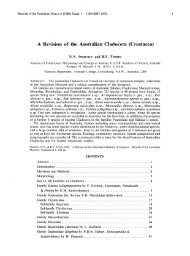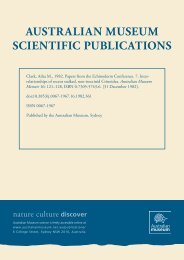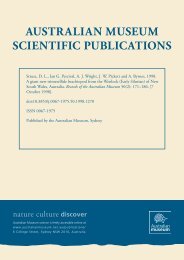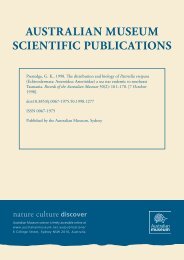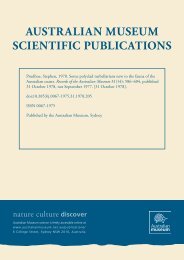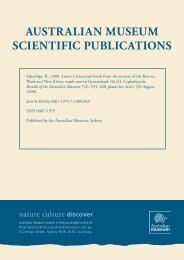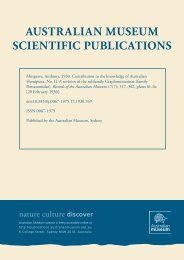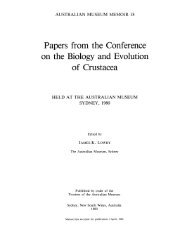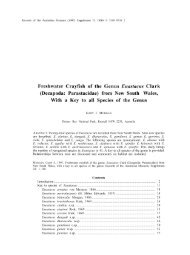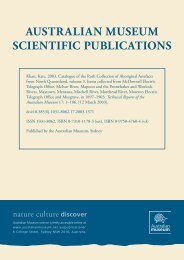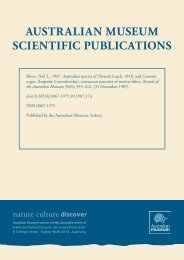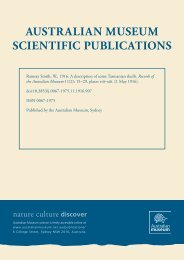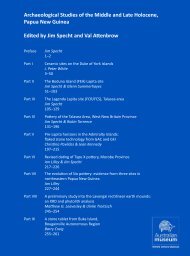A simplified key to the sessile varnacles found on the rocks, boats ...
A simplified key to the sessile varnacles found on the rocks, boats ...
A simplified key to the sessile varnacles found on the rocks, boats ...
You also want an ePaper? Increase the reach of your titles
YUMPU automatically turns print PDFs into web optimized ePapers that Google loves.
AUSTRALIAN MUSEUM<br />
SCIENTIFIC PUBLICATIONS<br />
Pope, E. C., 1945. A <str<strong>on</strong>g>simplified</str<strong>on</strong>g> <str<strong>on</strong>g>key</str<strong>on</strong>g> <str<strong>on</strong>g>to</str<strong>on</strong>g> <str<strong>on</strong>g>the</str<strong>on</strong>g> <str<strong>on</strong>g>sessile</str<strong>on</strong>g> barnacles <str<strong>on</strong>g>found</str<strong>on</strong>g> <strong>on</strong> <str<strong>on</strong>g>the</str<strong>on</strong>g> <strong>rocks</strong>,<br />
<strong>boats</strong>, wharf piles and o<str<strong>on</strong>g>the</str<strong>on</strong>g>r installati<strong>on</strong>s in Port Jacks<strong>on</strong> and adjacent waters.<br />
Records of <str<strong>on</strong>g>the</str<strong>on</strong>g> Australian Museum 21(6): 351–372, plates xxviii–xxx. [25 June<br />
1945].<br />
doi:10.3853/j.0067-1975.21.1945.550<br />
ISSN 0067-1975<br />
Published by <str<strong>on</strong>g>the</str<strong>on</strong>g> Australian Museum, Sydney<br />
nature culture discover<br />
Australian Museum science is freely accessible <strong>on</strong>line at<br />
http://publicati<strong>on</strong>s.australianmuseum.net.au<br />
6 College Street, Sydney NSW 2010, Australia
A SIMPLIFIED KEY TO THE SESSILE BARNACLES<br />
FOUND ON THE ROCKS, BOATS. WHARF PILES<br />
AND OTHER INSTALLATIONS IN PORT JACKSON<br />
AND ADJACENT WATERS.<br />
By ELIZABETH C. POPE, M.Sc.,<br />
The Australian Museum, Sydney.<br />
(Plates xxviii-xxx; Figures 1-5.)<br />
Introducti<strong>on</strong>.<br />
It is generally c<strong>on</strong>sidered by dock authorities that <str<strong>on</strong>g>the</str<strong>on</strong>g> fouling of ship bot<str<strong>on</strong>g>to</str<strong>on</strong>g>ms by<br />
barnacles in <str<strong>on</strong>g>the</str<strong>on</strong>g> harbour of Sydney, Port Jacks<strong>on</strong>, is heavy in comparis<strong>on</strong> with o<str<strong>on</strong>g>the</str<strong>on</strong>g>r<br />
localities. Unlike most o<str<strong>on</strong>g>the</str<strong>on</strong>g>r organisms which attach <str<strong>on</strong>g>the</str<strong>on</strong>g>mselves <str<strong>on</strong>g>to</str<strong>on</strong>g> <str<strong>on</strong>g>the</str<strong>on</strong>g> bot<str<strong>on</strong>g>to</str<strong>on</strong>g>ms of<br />
ships, barnacle shells do not necessarily drop off or decay away <strong>on</strong>ce <str<strong>on</strong>g>the</str<strong>on</strong>g> organism in<br />
<str<strong>on</strong>g>the</str<strong>on</strong>g>m dies, and docking and scraping are necessary <str<strong>on</strong>g>to</str<strong>on</strong>g> remove <str<strong>on</strong>g>the</str<strong>on</strong>g>m effectively. This is<br />
an expensive process and c<strong>on</strong>sequently much attenti<strong>on</strong> is being given <str<strong>on</strong>g>to</str<strong>on</strong>g> <str<strong>on</strong>g>the</str<strong>on</strong>g> producti<strong>on</strong><br />
of anti-fouling substances for use <strong>on</strong> harbour installati<strong>on</strong>s. Actually it is possible that a<br />
coating c<strong>on</strong>sisting of thousands of barnacles <strong>on</strong> a wharf pile or o<str<strong>on</strong>g>the</str<strong>on</strong>g>r wooden structure<br />
under water may itself, by <str<strong>on</strong>g>the</str<strong>on</strong>g> c<strong>on</strong>stant feeding of <str<strong>on</strong>g>the</str<strong>on</strong>g> individuals, cause c<strong>on</strong>siderable<br />
reducti<strong>on</strong> in <str<strong>on</strong>g>the</str<strong>on</strong>g> numbers of swimming larvae of such undesirable wood-borers as <str<strong>on</strong>g>the</str<strong>on</strong>g><br />
shipworm or Cobra (Teredinine borers).<br />
Much work remains <str<strong>on</strong>g>to</str<strong>on</strong>g> be d<strong>on</strong>e in c<strong>on</strong>necti<strong>on</strong> with both <str<strong>on</strong>g>the</str<strong>on</strong>g>se problems, and it has<br />
become a primary necessity for <str<strong>on</strong>g>the</str<strong>on</strong>g> field worker <str<strong>on</strong>g>to</str<strong>on</strong>g> be able <str<strong>on</strong>g>to</str<strong>on</strong>g> distinguish quickly and<br />
easily <str<strong>on</strong>g>the</str<strong>on</strong>g> differe.nt species of barnacles <str<strong>on</strong>g>found</str<strong>on</strong>g> in <str<strong>on</strong>g>the</str<strong>on</strong>g> waters of Port Jacks<strong>on</strong>. The<br />
various m<strong>on</strong>ographs and scientific papers dealing with this group of crustaceans are not<br />
as a rule easy of access <str<strong>on</strong>g>to</str<strong>on</strong>g> <str<strong>on</strong>g>the</str<strong>on</strong>g> workers <strong>on</strong> <str<strong>on</strong>g>the</str<strong>on</strong>g>se problems and often c<strong>on</strong>tain unnecessarily<br />
detailed descripti<strong>on</strong>s of <str<strong>on</strong>g>the</str<strong>on</strong>g> various speCies. This simple <str<strong>on</strong>g>key</str<strong>on</strong>g> has <str<strong>on</strong>g>the</str<strong>on</strong>g>refore been<br />
drawn up <str<strong>on</strong>g>to</str<strong>on</strong>g> help <str<strong>on</strong>g>the</str<strong>on</strong>g>se workers. The author has assumed that some of <str<strong>on</strong>g>the</str<strong>on</strong>g> users of this<br />
<str<strong>on</strong>g>key</str<strong>on</strong>g> will be unfamiliar with <str<strong>on</strong>g>the</str<strong>on</strong>g> zoological terms usually applied <str<strong>on</strong>g>to</str<strong>on</strong>g> <str<strong>on</strong>g>the</str<strong>on</strong>g> various 'parts of<br />
<str<strong>on</strong>g>the</str<strong>on</strong>g> body and shells of <str<strong>on</strong>g>the</str<strong>on</strong>g>se animals. Accordingly, as few of <str<strong>on</strong>g>the</str<strong>on</strong>g>se technical terms as<br />
possible have been'introduced, and differences in field occurrence and external structure<br />
will be used, as far as may be, <str<strong>on</strong>g>to</str<strong>on</strong>g> distinguish between <strong>on</strong>e species and ano<str<strong>on</strong>g>the</str<strong>on</strong>g>r, ra<str<strong>on</strong>g>the</str<strong>on</strong>g>r<br />
than <str<strong>on</strong>g>the</str<strong>on</strong>g> very necessary finer points of ana<str<strong>on</strong>g>to</str<strong>on</strong>g>mical difference used by <str<strong>on</strong>g>the</str<strong>on</strong>g> specialists in<br />
this group. Workers desirous of more complete and detailed descripti<strong>on</strong>s should refer<br />
<str<strong>on</strong>g>to</str<strong>on</strong>g> Darwin's m<strong>on</strong>ograph (1854) <strong>on</strong> this group or some o<str<strong>on</strong>g>the</str<strong>on</strong>g>r later standard work of that<br />
nature.<br />
Relati<strong>on</strong>ships and Ana<str<strong>on</strong>g>to</str<strong>on</strong>g>my of <str<strong>on</strong>g>the</str<strong>on</strong>g> Barnacles.<br />
In spite of <str<strong>on</strong>g>the</str<strong>on</strong>g>ir appearance, barnacles are not molluscs like mussels or oysters, but<br />
are close relatives of <str<strong>on</strong>g>the</str<strong>on</strong>g> prawns, crabs and o<str<strong>on</strong>g>the</str<strong>on</strong>g>r crustaceans. They have been aptly<br />
described by Huxley as shrimp-like animals which have become attached by <str<strong>on</strong>g>the</str<strong>on</strong>g>ir head<br />
ends <str<strong>on</strong>g>to</str<strong>on</strong>g> some submerged object and <str<strong>on</strong>g>the</str<strong>on</strong>g>n have proceeded <str<strong>on</strong>g>to</str<strong>on</strong>g> c<strong>on</strong>struct round <str<strong>on</strong>g>the</str<strong>on</strong>g>ir<br />
bodies cases of armour-like plates. These plates butt <strong>on</strong>e against <str<strong>on</strong>g>the</str<strong>on</strong>g> next and serve as<br />
a protecti<strong>on</strong> for <str<strong>on</strong>g>the</str<strong>on</strong>g> soft parts of <str<strong>on</strong>g>the</str<strong>on</strong>g> body. The technical name for <str<strong>on</strong>g>the</str<strong>on</strong>g> barnacles is<br />
Cirripedia, bes<str<strong>on</strong>g>to</str<strong>on</strong>g>wed <strong>on</strong> <str<strong>on</strong>g>the</str<strong>on</strong>g>m because of <str<strong>on</strong>g>the</str<strong>on</strong>g>ir fea<str<strong>on</strong>g>the</str<strong>on</strong>g>ry, cirrus-like feet which are<br />
protruded through a gap between parts of <str<strong>on</strong>g>the</str<strong>on</strong>g> hard shelly coat when <str<strong>on</strong>g>the</str<strong>on</strong>g> animal is<br />
feeding. These fea<str<strong>on</strong>g>the</str<strong>on</strong>g>ry feet are used <str<strong>on</strong>g>to</str<strong>on</strong>g> "comb" <str<strong>on</strong>g>the</str<strong>on</strong>g> barnacles' food-particles from <str<strong>on</strong>g>the</str<strong>on</strong>g><br />
surrounding water.
352 RECORDS OF THE AUSTRALIAN MUSEUM.<br />
Of <str<strong>on</strong>g>the</str<strong>on</strong>g> barnacles encountered <strong>on</strong> <str<strong>on</strong>g>the</str<strong>on</strong>g> rocky foreshores and installati<strong>on</strong>s of Port<br />
Jacks<strong>on</strong>, two distinct kinds may easily be recognized: <str<strong>on</strong>g>the</str<strong>on</strong>g> stalked or "Goose" barnacles<br />
and <str<strong>on</strong>g>the</str<strong>on</strong>g> <str<strong>on</strong>g>sessile</str<strong>on</strong>g> or "Acorn" barnacles. In <str<strong>on</strong>g>the</str<strong>on</strong>g> stalked <strong>on</strong>es <str<strong>on</strong>g>the</str<strong>on</strong>g> body is protected by an<br />
outer covering of plates and <str<strong>on</strong>g>the</str<strong>on</strong>g> animal has a stalk or peduncle, sometimes several<br />
inches in length. In <str<strong>on</strong>g>the</str<strong>on</strong>g> <str<strong>on</strong>g>sessile</str<strong>on</strong>g> type <str<strong>on</strong>g>the</str<strong>on</strong>g>re is no stalk, and <str<strong>on</strong>g>the</str<strong>on</strong>g> soft parts of <str<strong>on</strong>g>the</str<strong>on</strong>g> animal<br />
which are surrounded by a roughly c<strong>on</strong>e-shaped wall of plates, grow directly attached<br />
<str<strong>on</strong>g>to</str<strong>on</strong>g> objects such as s<str<strong>on</strong>g>to</str<strong>on</strong>g>nes, piling, ships' bot<str<strong>on</strong>g>to</str<strong>on</strong>g>ms or <str<strong>on</strong>g>the</str<strong>on</strong>g> shells of o<str<strong>on</strong>g>the</str<strong>on</strong>g>r animals. The<br />
stalked barnacles are mainly creatures of <str<strong>on</strong>g>the</str<strong>on</strong>g> ocean waters, while <str<strong>on</strong>g>the</str<strong>on</strong>g> acorn barnacles<br />
are comm<strong>on</strong>est al<strong>on</strong>g <str<strong>on</strong>g>the</str<strong>on</strong>g> shores and shallow seas. It is with <str<strong>on</strong>g>the</str<strong>on</strong>g> latter group that this<br />
paper is c<strong>on</strong>cerned.<br />
The barnacle reveals its real nature and its close affinity with o<str<strong>on</strong>g>the</str<strong>on</strong>g>r crustaceans in<br />
its life-his<str<strong>on</strong>g>to</str<strong>on</strong>g>ry because <str<strong>on</strong>g>the</str<strong>on</strong>g> young leave <str<strong>on</strong>g>the</str<strong>on</strong>g> parent as <str<strong>on</strong>g>the</str<strong>on</strong>g> typical free-swimming<br />
crustacean larva called a nauplius. In this stage <str<strong>on</strong>g>the</str<strong>on</strong>g> young may be scattered far from<br />
<str<strong>on</strong>g>the</str<strong>on</strong>g>ir place of origin by currents. As <str<strong>on</strong>g>the</str<strong>on</strong>g> young larva grows, it undergoes several moults<br />
and changes its appearance radically, growing a two-piece shell and resembling ano<str<strong>on</strong>g>the</str<strong>on</strong>g>r<br />
small crustacean type, <str<strong>on</strong>g>the</str<strong>on</strong>g> Ostracod Oypris, very closely in appearance. FOr this reas<strong>on</strong><br />
<str<strong>on</strong>g>the</str<strong>on</strong>g> young barnacle at this stage of its development is called <str<strong>on</strong>g>the</str<strong>on</strong>g> cypris stage.<br />
The cypris stage swims about in <str<strong>on</strong>g>the</str<strong>on</strong>g> sea and seeks out a spot suitable for attaching<br />
itself. It does this by means of an adhesive cement poured out by a gland situated<br />
<str<strong>on</strong>g>to</str<strong>on</strong>g>wards <str<strong>on</strong>g>the</str<strong>on</strong>g> head end· of <str<strong>on</strong>g>the</str<strong>on</strong>g> body. After this stage, all <str<strong>on</strong>g>the</str<strong>on</strong>g> limbs of <str<strong>on</strong>g>the</str<strong>on</strong>g> adult are<br />
present. Thebivalved shell remains until <str<strong>on</strong>g>the</str<strong>on</strong>g> barnacle is attached and <str<strong>on</strong>g>the</str<strong>on</strong>g>n is cast off<br />
and <str<strong>on</strong>g>the</str<strong>on</strong>g> plates of <str<strong>on</strong>g>the</str<strong>on</strong>g> adult shell begin <str<strong>on</strong>g>to</str<strong>on</strong>g> grow, being laid down by an outer covering of<br />
<str<strong>on</strong>g>the</str<strong>on</strong>g> body.<br />
In order <str<strong>on</strong>g>to</str<strong>on</strong>g> determine <str<strong>on</strong>g>the</str<strong>on</strong>g> genus of a barnacle it is necessary <str<strong>on</strong>g>to</str<strong>on</strong>g> be able <str<strong>on</strong>g>to</str<strong>on</strong>g> orientate<br />
and know <str<strong>on</strong>g>the</str<strong>on</strong>g> names of some parts of <str<strong>on</strong>g>the</str<strong>on</strong>g> shell and body.<br />
The shell c<strong>on</strong>sists of a basis and a circular wall made up of 4, 6 or 8 main plates.<br />
These abut <strong>on</strong>e against <str<strong>on</strong>g>the</str<strong>on</strong>g> next <str<strong>on</strong>g>to</str<strong>on</strong>g> make <str<strong>on</strong>g>the</str<strong>on</strong>g> solid outer coat of <str<strong>on</strong>g>the</str<strong>on</strong>g> animal. The basis<br />
is closely applied <str<strong>on</strong>g>to</str<strong>on</strong>g> <str<strong>on</strong>g>the</str<strong>on</strong>g> substratum <strong>on</strong> which <str<strong>on</strong>g>the</str<strong>on</strong>g> barnacle is growing and may be fiat<br />
or cup-like and calcareous or membranous. Where <str<strong>on</strong>g>the</str<strong>on</strong>g> basis is calcareous it may be solid,<br />
or may have a series of radiating' channels in it, called pores. The plates of <str<strong>on</strong>g>the</str<strong>on</strong>g> shell<br />
are separated from <strong>on</strong>e ano<str<strong>on</strong>g>the</str<strong>on</strong>g>r by sutures which can be quite distinct or may be<br />
obliterated as <str<strong>on</strong>g>the</str<strong>on</strong>g> barnacle matures and grows old.<br />
At <str<strong>on</strong>g>the</str<strong>on</strong>g> upper or free end of <str<strong>on</strong>g>the</str<strong>on</strong>g> shell is <str<strong>on</strong>g>the</str<strong>on</strong>g> opening <str<strong>on</strong>g>to</str<strong>on</strong>g> <str<strong>on</strong>g>the</str<strong>on</strong>g> outside world, <str<strong>on</strong>g>the</str<strong>on</strong>g><br />
orifice, <str<strong>on</strong>g>the</str<strong>on</strong>g> shape of which is often an aid in <str<strong>on</strong>g>the</str<strong>on</strong>g> determinati<strong>on</strong> of <str<strong>on</strong>g>the</str<strong>on</strong>g> species. The<br />
orifice is closed by a lid-like structure, <str<strong>on</strong>g>the</str<strong>on</strong>g> operculUm, which is joined <str<strong>on</strong>g>to</str<strong>on</strong>g> <str<strong>on</strong>g>the</str<strong>on</strong>g> wall-like<br />
Orifice<br />
Figure l.-Diagram of <str<strong>on</strong>g>the</str<strong>on</strong>g> whole shell of a barnacle. A., alae; B., basis;<br />
Car., carina; Lat. PI., lateral plates; P., parietes; R., radius; Ros., rostrum;<br />
S., suture; Se., scutum; Te., tergum.
A SIMPLIFIED KEY '1'0 THE SESSILE BARNACLES-ELIZABETH C. POPE. 353<br />
part of <str<strong>on</strong>g>the</str<strong>on</strong>g> shell by a chitinous opercular me1l1;brane. The operculum is made up of two<br />
pairs of small shells or valves known as <str<strong>on</strong>g>the</str<strong>on</strong>g> scuta and terga and between <str<strong>on</strong>g>the</str<strong>on</strong>g>m is a<br />
slit-like opening which leads in<str<strong>on</strong>g>to</str<strong>on</strong>g> <str<strong>on</strong>g>the</str<strong>on</strong>g> sac inside <str<strong>on</strong>g>the</str<strong>on</strong>g> shell, where <str<strong>on</strong>g>the</str<strong>on</strong>g> soft body-parts lie.<br />
It is through this slit that <str<strong>on</strong>g>the</str<strong>on</strong>g> fea<str<strong>on</strong>g>the</str<strong>on</strong>g>ry I',irri are poked when <str<strong>on</strong>g>the</str<strong>on</strong>g> animal feeds<br />
(Figs. 1, 2).<br />
The structure of <str<strong>on</strong>g>the</str<strong>on</strong>g> opercular valves is of <str<strong>on</strong>g>the</str<strong>on</strong>g> utmost importance as an aid<br />
<str<strong>on</strong>g>to</str<strong>on</strong>g> <str<strong>on</strong>g>the</str<strong>on</strong>g> identificati<strong>on</strong> of barnacle species and should always be taken in<str<strong>on</strong>g>to</str<strong>on</strong>g> account when<br />
checking field identificati<strong>on</strong>s. A low-powered microscope is generally necessary for<br />
viewing <str<strong>on</strong>g>the</str<strong>on</strong>g>se valves, but in <str<strong>on</strong>g>the</str<strong>on</strong>g> larger species a hand lens may be sufficient (Figs. 3, 4).<br />
Figure 2.-Diagramof barnacle with part of shell removed <str<strong>on</strong>g>to</str<strong>on</strong>g> display<br />
soft parts. Ad. Mus., adduc<str<strong>on</strong>g>to</str<strong>on</strong>g>r muscle cut end; B., basis; C., cirri; Car.,<br />
carina; Lab., labrum; Mus., muscle; Op. Mem., opercular membrane; Ov.,<br />
ovary; Pros., prosoma; Ros., rostrum; Sc., scutum; Sh., tip of sheath;<br />
St. R., regi<strong>on</strong> of s<str<strong>on</strong>g>to</str<strong>on</strong>g>mach; T., thorax; Te., tergum.<br />
Each plate of <str<strong>on</strong>g>the</str<strong>on</strong>g> shell, apart from <str<strong>on</strong>g>the</str<strong>on</strong>g> opercular valves, c<strong>on</strong>sists of a central,<br />
triangular-shaped secti<strong>on</strong>, <str<strong>on</strong>g>the</str<strong>on</strong>g> paries (plural parietes) with, as a rule, two side parts<br />
called ei<str<strong>on</strong>g>the</str<strong>on</strong>g>r radii or alae according <str<strong>on</strong>g>to</str<strong>on</strong>g> whe<str<strong>on</strong>g>the</str<strong>on</strong>g>r <str<strong>on</strong>g>the</str<strong>on</strong>g>y overlap or underlie <str<strong>on</strong>g>the</str<strong>on</strong>g> side parts<br />
of <str<strong>on</strong>g>the</str<strong>on</strong>g> adjacent plate. Side pieces which overlap <str<strong>on</strong>g>the</str<strong>on</strong>g> next plate are called raaii, and<br />
those which underlie <str<strong>on</strong>g>the</str<strong>on</strong>g>m are called alae. A plate may have alae <strong>on</strong> ei<str<strong>on</strong>g>the</str<strong>on</strong>g>r side of <str<strong>on</strong>g>the</str<strong>on</strong>g><br />
central porti<strong>on</strong> or radii, or <strong>on</strong>e radius and <strong>on</strong>e ala. (See Fig. 1.)<br />
Examinati<strong>on</strong> of <str<strong>on</strong>g>the</str<strong>on</strong>g> basal end of a shell-plate of a barnacle such as Tetraclita rosea<br />
shows that <str<strong>on</strong>g>the</str<strong>on</strong>g> walls are not always simple, single-layered structures. Generally <str<strong>on</strong>g>the</str<strong>on</strong>g>re is<br />
an outer and an inner lamina across which run streng<str<strong>on</strong>g>the</str<strong>on</strong>g>ning septa dividing <str<strong>on</strong>g>the</str<strong>on</strong>g> walls<br />
in<str<strong>on</strong>g>to</str<strong>on</strong>g> a series of tubes or pores. Fur<str<strong>on</strong>g>the</str<strong>on</strong>g>r branchings of <str<strong>on</strong>g>the</str<strong>on</strong>g> septa may lead <str<strong>on</strong>g>to</str<strong>on</strong>g> <str<strong>on</strong>g>the</str<strong>on</strong>g><br />
formati<strong>on</strong> of more than <strong>on</strong>e row of pores between <str<strong>on</strong>g>the</str<strong>on</strong>g> outer and <str<strong>on</strong>g>the</str<strong>on</strong>g> inner lamina of<br />
each shell-plate. Such a state of affairs is <str<strong>on</strong>g>found</str<strong>on</strong>g> in Tetraclita purpurascens (Plate xxix,<br />
fig. 3).<br />
The various plates in <str<strong>on</strong>g>the</str<strong>on</strong>g> shell have names, and since <str<strong>on</strong>g>the</str<strong>on</strong>g> genus is generally decided<br />
by <str<strong>on</strong>g>the</str<strong>on</strong>g> arrangement of <str<strong>on</strong>g>the</str<strong>on</strong>g>se shell parts it is necessary <str<strong>on</strong>g>to</str<strong>on</strong>g> know some of <str<strong>on</strong>g>the</str<strong>on</strong>g>m. The most<br />
primitive type of acorn barnacle <str<strong>on</strong>g>found</str<strong>on</strong>g> <str<strong>on</strong>g>to</str<strong>on</strong>g>day is <str<strong>on</strong>g>the</str<strong>on</strong>g> genus Oa<str<strong>on</strong>g>to</str<strong>on</strong>g>phragmus, and its shell<br />
is made up of eight main plates with numerous whorls of smaller <strong>on</strong>es outside. But<br />
in most o<str<strong>on</strong>g>the</str<strong>on</strong>g>r genera <str<strong>on</strong>g>the</str<strong>on</strong>g>re has been a reducti<strong>on</strong> in <str<strong>on</strong>g>the</str<strong>on</strong>g> number of main plates <str<strong>on</strong>g>to</str<strong>on</strong>g> six or<br />
four, and <str<strong>on</strong>g>the</str<strong>on</strong>g> outer whorls of small plates or scales are absent al<str<strong>on</strong>g>to</str<strong>on</strong>g>ge<str<strong>on</strong>g>the</str<strong>on</strong>g>r. This reducti<strong>on</strong><br />
in <str<strong>on</strong>g>the</str<strong>on</strong>g> number has, been brought about by fusi<strong>on</strong> of some of <str<strong>on</strong>g>the</str<strong>on</strong>g> plates. Such a fusi<strong>on</strong><br />
during <str<strong>on</strong>g>the</str<strong>on</strong>g> development from juvenile <str<strong>on</strong>g>to</str<strong>on</strong>g> adult form of an individual has been observed<br />
and described by Miss Lucy B. Moore (1944) in <str<strong>on</strong>g>the</str<strong>on</strong>g> barnacle Ohamaesipho brunnea,<br />
where <str<strong>on</strong>g>the</str<strong>on</strong>g> juvenile definitely has six plates and <str<strong>on</strong>g>the</str<strong>on</strong>g> adult four.<br />
The plate situated at <str<strong>on</strong>g>the</str<strong>on</strong>g> end of <str<strong>on</strong>g>the</str<strong>on</strong>g> shell where <str<strong>on</strong>g>the</str<strong>on</strong>g> cirri are poked out (<str<strong>on</strong>g>the</str<strong>on</strong>g> end of<br />
<str<strong>on</strong>g>the</str<strong>on</strong>g> shell where <str<strong>on</strong>g>the</str<strong>on</strong>g> tergal opercular valves are) is called <str<strong>on</strong>g>the</str<strong>on</strong>g> carina. This plate always
354 RECORDS OF THE AUSTRALIAN MUSEUM.<br />
has two alae and is, <str<strong>on</strong>g>the</str<strong>on</strong>g>refore, overlapped by adjacent plates. The plate in <str<strong>on</strong>g>the</str<strong>on</strong>g> shell<br />
directly opposite <str<strong>on</strong>g>to</str<strong>on</strong>g> <str<strong>on</strong>g>the</str<strong>on</strong>g> carina is <str<strong>on</strong>g>the</str<strong>on</strong>g> rostrum. In more primitive types of barnacles it<br />
also has two alae like <str<strong>on</strong>g>the</str<strong>on</strong>g> carina, and should <str<strong>on</strong>g>the</str<strong>on</strong>g> shell-pieces or such a barnacle become<br />
detached it is <str<strong>on</strong>g>the</str<strong>on</strong>g>n difficult <str<strong>on</strong>g>to</str<strong>on</strong>g> distinguish <str<strong>on</strong>g>the</str<strong>on</strong>g> carina from <str<strong>on</strong>g>the</str<strong>on</strong>g> rostrum. Usually,<br />
however, <str<strong>on</strong>g>the</str<strong>on</strong>g> carina is more bent than <str<strong>on</strong>g>the</str<strong>on</strong>g> rostrum of <str<strong>on</strong>g>the</str<strong>on</strong>g> same species and in this way<br />
can be distinguished. Between <str<strong>on</strong>g>the</str<strong>on</strong>g> carina and <str<strong>on</strong>g>the</str<strong>on</strong>g> rostrum lie <str<strong>on</strong>g>the</str<strong>on</strong>g> lateral plates ranging<br />
from three pairs <str<strong>on</strong>g>to</str<strong>on</strong>g> <strong>on</strong>e pair in number. It is not necessary for <str<strong>on</strong>g>the</str<strong>on</strong>g> purposes of this<br />
paper <str<strong>on</strong>g>to</str<strong>on</strong>g> know <str<strong>on</strong>g>the</str<strong>on</strong>g>ir names, but in determining <str<strong>on</strong>g>the</str<strong>on</strong>g> genus it is necessary <str<strong>on</strong>g>to</str<strong>on</strong>g> know<br />
<str<strong>on</strong>g>the</str<strong>on</strong>g>ir arrangement and <str<strong>on</strong>g>to</str<strong>on</strong>g> know whe<str<strong>on</strong>g>the</str<strong>on</strong>g>r <str<strong>on</strong>g>the</str<strong>on</strong>g>y overlap or underlie <str<strong>on</strong>g>the</str<strong>on</strong>g> plates <strong>on</strong> ei<str<strong>on</strong>g>the</str<strong>on</strong>g>r side.<br />
A rough cross-secti9nal diagram of <str<strong>on</strong>g>the</str<strong>on</strong>g> arrangement of <str<strong>on</strong>g>the</str<strong>on</strong>g> plates in <str<strong>on</strong>g>the</str<strong>on</strong>g> upper part of<br />
<str<strong>on</strong>g>the</str<strong>on</strong>g> shell should be made for comparis<strong>on</strong> with those in Figure 5.<br />
B.M. At.D.Mus.<br />
Figure 3. Figure 4.<br />
Figure 3.-Scutum, inside view. A., apex; Ad. R., adduc<str<strong>on</strong>g>to</str<strong>on</strong>g>r ridge;<br />
At. D. Mus., Attachment of depressor muscle; Art. F., articular furrow;<br />
B.M., basal margin; C.R. Dep., crests for rostra! depressor; Oc. M., occludent<br />
margin; S. Ad. Mus., scar of adduc<str<strong>on</strong>g>to</str<strong>on</strong>g>r muscle; R.C., rostral corner.<br />
Figure 4.-Tergum, inside view. A., apex or beak; Art. F., articular<br />
furrow; Art. R., articular ridge; B.Sc.C., basi-scutal corner; Car. M., carinal<br />
margin; C. Dep. Mus., crests for depressor muscle; Sc. M., scutal margin;<br />
Sp., spur.<br />
If part of <str<strong>on</strong>g>the</str<strong>on</strong>g> shell be removed, so that <str<strong>on</strong>g>the</str<strong>on</strong>g> soft body of <str<strong>on</strong>g>the</str<strong>on</strong>g> barnacle is displayed,<br />
<str<strong>on</strong>g>the</str<strong>on</strong>g> six posterior thoracic segments of <str<strong>on</strong>g>the</str<strong>on</strong>g> body may easily be recognized because <str<strong>on</strong>g>the</str<strong>on</strong>g>y<br />
bear <str<strong>on</strong>g>the</str<strong>on</strong>g> fea<str<strong>on</strong>g>the</str<strong>on</strong>g>ry cirri. In fr<strong>on</strong>t of <str<strong>on</strong>g>the</str<strong>on</strong>g>m is a large swollen-looking porti<strong>on</strong> called <str<strong>on</strong>g>the</str<strong>on</strong>g><br />
prosoma which houses <str<strong>on</strong>g>the</str<strong>on</strong>g> s<str<strong>on</strong>g>to</str<strong>on</strong>g>mach regi<strong>on</strong> of <str<strong>on</strong>g>the</str<strong>on</strong>g> barnacle. There is no abdomen comparable<br />
with that <str<strong>on</strong>g>found</str<strong>on</strong>g> in o<str<strong>on</strong>g>the</str<strong>on</strong>g>r crustaceans (Fig. 2).<br />
The mouth is situated in fr<strong>on</strong>t of <str<strong>on</strong>g>the</str<strong>on</strong>g> base of <str<strong>on</strong>g>the</str<strong>on</strong>g> first pair of cirri and is furnished<br />
with a prominent upper lip or labrum and four pairs of jaws. The finer structural<br />
differences of some of <str<strong>on</strong>g>the</str<strong>on</strong>g>se are used as criteria for identificati<strong>on</strong>s by specialists.<br />
The c<strong>on</strong>diti<strong>on</strong> of <str<strong>on</strong>g>the</str<strong>on</strong>g> eggs in <str<strong>on</strong>g>the</str<strong>on</strong>g> ovaries may easily be observed, for <str<strong>on</strong>g>the</str<strong>on</strong>g> eggs lie<br />
at <str<strong>on</strong>g>the</str<strong>on</strong>g> base of <str<strong>on</strong>g>the</str<strong>on</strong>g> sac and are easy of access.<br />
Determinati<strong>on</strong> of <str<strong>on</strong>g>the</str<strong>on</strong>g> Family.<br />
As a first step <str<strong>on</strong>g>to</str<strong>on</strong>g>wards identificati<strong>on</strong>, <str<strong>on</strong>g>the</str<strong>on</strong>g> barnacle should be orientated so that <str<strong>on</strong>g>the</str<strong>on</strong>g><br />
carinal and rostral plates are known. A note should be made whe<str<strong>on</strong>g>the</str<strong>on</strong>g>r <str<strong>on</strong>g>the</str<strong>on</strong>g> rostrum has<br />
two radii or two alae, as this determines <str<strong>on</strong>g>the</str<strong>on</strong>g> family <str<strong>on</strong>g>to</str<strong>on</strong>g> which <str<strong>on</strong>g>the</str<strong>on</strong>g> barnacle bel<strong>on</strong>gs. Use<br />
of Figure 5 will help <str<strong>on</strong>g>to</str<strong>on</strong>g> determine <str<strong>on</strong>g>the</str<strong>on</strong>g> genus of <str<strong>on</strong>g>the</str<strong>on</strong>g> barnacle. Subsequent use of <str<strong>on</strong>g>the</str<strong>on</strong>g> <str<strong>on</strong>g>key</str<strong>on</strong>g>s<br />
for <str<strong>on</strong>g>the</str<strong>on</strong>g> species of each genus will <str<strong>on</strong>g>the</str<strong>on</strong>g>n determine any of <str<strong>on</strong>g>the</str<strong>on</strong>g> more comm<strong>on</strong> Sydney<br />
species likely <str<strong>on</strong>g>to</str<strong>on</strong>g> be encountered <strong>on</strong> harbour <strong>rocks</strong> and installati<strong>on</strong>s.<br />
C<strong>on</strong>firmati<strong>on</strong> of <str<strong>on</strong>g>the</str<strong>on</strong>g> family <str<strong>on</strong>g>to</str<strong>on</strong>g> which <str<strong>on</strong>g>the</str<strong>on</strong>g> barnacle bel<strong>on</strong>gs can be made by making<br />
an examinati<strong>on</strong> of <str<strong>on</strong>g>the</str<strong>on</strong>g> labrum. In <strong>on</strong>e family, <str<strong>on</strong>g>the</str<strong>on</strong>g> Balanidae, <str<strong>on</strong>g>the</str<strong>on</strong>g>re is always a central<br />
notch in <str<strong>on</strong>g>the</str<strong>on</strong>g> labrum, whereas in <str<strong>on</strong>g>the</str<strong>on</strong>g> family Ohthamalidae <str<strong>on</strong>g>the</str<strong>on</strong>g>re is a c<strong>on</strong>cave edge <str<strong>on</strong>g>to</str<strong>on</strong>g> <str<strong>on</strong>g>the</str<strong>on</strong>g><br />
labrum, but it is not sharply notched as in <str<strong>on</strong>g>the</str<strong>on</strong>g> previous family (Figure 5). While it is<br />
not generally necessary <str<strong>on</strong>g>to</str<strong>on</strong>g> resort <str<strong>on</strong>g>to</str<strong>on</strong>g> <str<strong>on</strong>g>the</str<strong>on</strong>g> use of this latter character f.or family
356 RECORDS OF THE AUSTRALIAN MUSEUM.<br />
Ca<str<strong>on</strong>g>to</str<strong>on</strong>g>phragmus (Ca<str<strong>on</strong>g>to</str<strong>on</strong>g>merus) polymerus IJarwin.<br />
(Plate xxviii, fig. 1; and Plate xxx, figs. 1-2.)<br />
Appearance.-This barnacle has a most characteristic structure and may be identified<br />
by <str<strong>on</strong>g>the</str<strong>on</strong>g> outer whorls of plates or scales which surround <str<strong>on</strong>g>the</str<strong>on</strong>g> eight principal <strong>on</strong>es making<br />
up <str<strong>on</strong>g>the</str<strong>on</strong>g> wall. Each of <str<strong>on</strong>g>the</str<strong>on</strong>g>se small scales over lies <str<strong>on</strong>g>the</str<strong>on</strong>g> suture between two adjacent plates<br />
of <str<strong>on</strong>g>the</str<strong>on</strong>g> row immediately inside it. The scales increase in number but decrease in size in<br />
<str<strong>on</strong>g>the</str<strong>on</strong>g> outer whorls. On occasi<strong>on</strong>s, when a specimen is so eroded that <str<strong>on</strong>g>the</str<strong>on</strong>g> relati<strong>on</strong>ships<br />
of <str<strong>on</strong>g>the</str<strong>on</strong>g> radii and alae of <str<strong>on</strong>g>the</str<strong>on</strong>g> principal plates cannot be seen, <str<strong>on</strong>g>the</str<strong>on</strong>g>se additi<strong>on</strong>al whorls make<br />
identificati<strong>on</strong> simple.<br />
Size.-Large specimens may grow till <str<strong>on</strong>g>the</str<strong>on</strong>g> basal diameter is about og.e and a quarter<br />
inches, but slightly less than <strong>on</strong>e inch is <str<strong>on</strong>g>the</str<strong>on</strong>g> typical size.<br />
Basis.-The basis is thin and membranous.<br />
Oolour.-The general colour of <str<strong>on</strong>g>the</str<strong>on</strong>g> plates is grey-green, but <str<strong>on</strong>g>the</str<strong>on</strong>g> shell is sometimes<br />
coated with a hairy, brown-coloured alga.<br />
Opercular Valves.-The scuta bear prominent articular ridges with deep furrows<br />
above and below, in<str<strong>on</strong>g>to</str<strong>on</strong>g> which fit corresp<strong>on</strong>ding ridges <strong>on</strong> <str<strong>on</strong>g>the</str<strong>on</strong>g> tergum. The tergum has<br />
a most marked articular furrow and <str<strong>on</strong>g>the</str<strong>on</strong>g> crests for <str<strong>on</strong>g>the</str<strong>on</strong>g> attachment of <str<strong>on</strong>g>the</str<strong>on</strong>g> depressor<br />
muscles extend half-way across <str<strong>on</strong>g>the</str<strong>on</strong>g> basal margin of <str<strong>on</strong>g>the</str<strong>on</strong>g> valve. There is no true spur.<br />
Habitat.-Ga<str<strong>on</strong>g>to</str<strong>on</strong>g>phragmu8 is popularly known as <str<strong>on</strong>g>the</str<strong>on</strong>g> Surf Barnacle, since its requirements<br />
seem <str<strong>on</strong>g>to</str<strong>on</strong>g> be a moderately high positi<strong>on</strong>, above low water mark, near <str<strong>on</strong>g>the</str<strong>on</strong>g> seaward<br />
edge of a rocky headland. Here, though it is out of water for some hours during <str<strong>on</strong>g>the</str<strong>on</strong>g><br />
low tide, it is never<str<strong>on</strong>g>the</str<strong>on</strong>g>less ba<str<strong>on</strong>g>the</str<strong>on</strong>g>d in spray and kept moist all <str<strong>on</strong>g>the</str<strong>on</strong>g> time.<br />
Best developed col<strong>on</strong>ies of Ga<str<strong>on</strong>g>to</str<strong>on</strong>g>phragmus are <str<strong>on</strong>g>found</str<strong>on</strong>g> <strong>on</strong> almost vertical rock faces,<br />
exposed <str<strong>on</strong>g>to</str<strong>on</strong>g> <str<strong>on</strong>g>the</str<strong>on</strong>g> surf, at <str<strong>on</strong>g>the</str<strong>on</strong>g> outer edges of rock platforms. In such positi<strong>on</strong>s <str<strong>on</strong>g>the</str<strong>on</strong>g>y may<br />
grow so closely as <str<strong>on</strong>g>to</str<strong>on</strong>g> form an almost c<strong>on</strong>tinuous, frieze-like band several feet high.<br />
Normally such a 'frieze' is <str<strong>on</strong>g>found</str<strong>on</strong>g> above <str<strong>on</strong>g>the</str<strong>on</strong>g> level of <str<strong>on</strong>g>the</str<strong>on</strong>g> reef where Balanus nigrescens<br />
grows and below <str<strong>on</strong>g>the</str<strong>on</strong>g> spots chosen by Tetraclita rosea, but <strong>on</strong> flatter rock platforms<br />
<str<strong>on</strong>g>the</str<strong>on</strong>g>se three species may all be <str<strong>on</strong>g>found</str<strong>on</strong>g> growing <str<strong>on</strong>g>to</str<strong>on</strong>g>ge<str<strong>on</strong>g>the</str<strong>on</strong>g>r at <str<strong>on</strong>g>the</str<strong>on</strong>g> <strong>on</strong>e level, and extending a<br />
c<strong>on</strong>siderable way up in<str<strong>on</strong>g>to</str<strong>on</strong>g> <str<strong>on</strong>g>the</str<strong>on</strong>g> tidal area.<br />
Localities.-Newport; L<strong>on</strong>g Reef; North Head, Port Jacks<strong>on</strong>; Middle Head, Port<br />
Jacks<strong>on</strong>; Hunter's Beach, Port Jacks<strong>on</strong>; B<strong>on</strong>di; Maroubra.<br />
Remarks.-Near Port Jacks<strong>on</strong> Ga,<str<strong>on</strong>g>to</str<strong>on</strong>g>phragmus is <str<strong>on</strong>g>found</str<strong>on</strong>g> chiefly <strong>on</strong> <str<strong>on</strong>g>the</str<strong>on</strong>g> open coast and<br />
not <str<strong>on</strong>g>to</str<strong>on</strong>g> any great extent in <str<strong>on</strong>g>the</str<strong>on</strong>g> harbour itself. It is, <str<strong>on</strong>g>the</str<strong>on</strong>g>refore, not an organism which<br />
fouls harbour installati<strong>on</strong>s.<br />
The genus Ga<str<strong>on</strong>g>to</str<strong>on</strong>g>phragmus has been divided in<str<strong>on</strong>g>to</str<strong>on</strong>g> three sub-genera and <str<strong>on</strong>g>the</str<strong>on</strong>g> local<br />
species bel<strong>on</strong>gs <str<strong>on</strong>g>to</str<strong>on</strong>g> <str<strong>on</strong>g>the</str<strong>on</strong>g> sub-genus Oa<str<strong>on</strong>g>to</str<strong>on</strong>g>merus.<br />
Chthamalus antennatus Darwin.<br />
(Plate xxviii, fig. 4; and Plate xxx, figs. 3-4.)<br />
Appearance.-Ghthamalus antennatus is a small barnacle with a very str<strong>on</strong>g shell,<br />
generally shaped like a flattened c<strong>on</strong>e. The outer surfaces of <str<strong>on</strong>g>the</str<strong>on</strong>g> shell-plates are often<br />
rugged and corroded (more rarely quite smooth). The sutures between <str<strong>on</strong>g>the</str<strong>on</strong>g> plates are<br />
very clearly marked and <str<strong>on</strong>g>the</str<strong>on</strong>g> orifice is small, el<strong>on</strong>gated, and sub-rhomboidal, with two<br />
shorter sides (<str<strong>on</strong>g>the</str<strong>on</strong>g> broader part of <str<strong>on</strong>g>the</str<strong>on</strong>g> orifice) <str<strong>on</strong>g>to</str<strong>on</strong>g>wards <str<strong>on</strong>g>the</str<strong>on</strong>g> carinal end of <str<strong>on</strong>g>the</str<strong>on</strong>g> shell.<br />
Size.-Large specimens are generally little more than half an inch in basal<br />
diameter and typical <strong>on</strong>es are slightly smaller.<br />
Basis.-The basis is membranous and black and, since <str<strong>on</strong>g>the</str<strong>on</strong>g> barnacle adheres very<br />
closely <str<strong>on</strong>g>to</str<strong>on</strong>g> <str<strong>on</strong>g>the</str<strong>on</strong>g> substratum, <str<strong>on</strong>g>the</str<strong>on</strong>g> roughened edges of <str<strong>on</strong>g>the</str<strong>on</strong>g> plates often give a wavy outline<br />
<str<strong>on</strong>g>to</str<strong>on</strong>g> it.<br />
Oolour.-The colour of <str<strong>on</strong>g>the</str<strong>on</strong>g> shell is generally a light dirty-grey with pale green or<br />
brown overlying it according <str<strong>on</strong>g>to</str<strong>on</strong>g> <str<strong>on</strong>g>the</str<strong>on</strong>g> state of erosi<strong>on</strong>. Internally <str<strong>on</strong>g>the</str<strong>on</strong>g> shell is lined by a<br />
black membrane which retains its colour even after preservati<strong>on</strong>.<br />
Opercular Valves.-The scutal valves are l<strong>on</strong>g and narrow and <str<strong>on</strong>g>the</str<strong>on</strong>g>re is a small but<br />
deep depressi<strong>on</strong> for <str<strong>on</strong>g>the</str<strong>on</strong>g>" attachment of <str<strong>on</strong>g>the</str<strong>on</strong>g> adduc<str<strong>on</strong>g>to</str<strong>on</strong>g>r muscle. There is also a prominent<br />
articular ridge which fits in<str<strong>on</strong>g>to</str<strong>on</strong>g> a corresp<strong>on</strong>dingly deep notch <strong>on</strong> <str<strong>on</strong>g>the</str<strong>on</strong>g> tergum. The tergum
A SIMPLIFIED KBY TO THE SESSILE BARNACLES-ELIZABETH C. POPE. 357<br />
is small (about half <str<strong>on</strong>g>the</str<strong>on</strong>g> size of <str<strong>on</strong>g>the</str<strong>on</strong>g> scutum) and has no spur, but possesses a few<br />
pr<strong>on</strong>ounced crests for <str<strong>on</strong>g>the</str<strong>on</strong>g> attachment of <str<strong>on</strong>g>the</str<strong>on</strong>g> depressor muscles near <str<strong>on</strong>g>the</str<strong>on</strong>g> basi-carinaI<br />
corner of <str<strong>on</strong>g>the</str<strong>on</strong>g> valve. Worn and eroded specimens often show this deep locking <str<strong>on</strong>g>to</str<strong>on</strong>g>ge<str<strong>on</strong>g>the</str<strong>on</strong>g>r<br />
of <str<strong>on</strong>g>the</str<strong>on</strong>g> opercular valves.<br />
Ha,bitat.-O. antennatus grows <strong>on</strong> <strong>rocks</strong> or <str<strong>on</strong>g>the</str<strong>on</strong>g> shells of molluscs living at a high<br />
level in <str<strong>on</strong>g>the</str<strong>on</strong>g> inter-tidal part of <str<strong>on</strong>g>the</str<strong>on</strong>g> shore. In fact, it manages <str<strong>on</strong>g>to</str<strong>on</strong>g> live <strong>on</strong> <strong>rocks</strong> which are<br />
<strong>on</strong>ly submerged during high spring tides and feeding can <strong>on</strong>ly take place at <str<strong>on</strong>g>the</str<strong>on</strong>g>se times.<br />
The rest of <str<strong>on</strong>g>the</str<strong>on</strong>g> time <str<strong>on</strong>g>the</str<strong>on</strong>g> barnacle obtains its moisture requirements from <str<strong>on</strong>g>the</str<strong>on</strong>g> spray in<br />
<str<strong>on</strong>g>the</str<strong>on</strong>g> air and opens its opercular valves <strong>on</strong>ly in <str<strong>on</strong>g>the</str<strong>on</strong>g> cooler parts of <str<strong>on</strong>g>the</str<strong>on</strong>g> day or during <str<strong>on</strong>g>the</str<strong>on</strong>g><br />
night. The necessity for c<strong>on</strong>tinual moistening of spray, <str<strong>on</strong>g>to</str<strong>on</strong>g>ge<str<strong>on</strong>g>the</str<strong>on</strong>g>r with its in<str<strong>on</strong>g>to</str<strong>on</strong>g>lerance of<br />
mud, limits <str<strong>on</strong>g>the</str<strong>on</strong>g> distributi<strong>on</strong> of this species <str<strong>on</strong>g>to</str<strong>on</strong>g> parts of <str<strong>on</strong>g>the</str<strong>on</strong>g> Port near <str<strong>on</strong>g>the</str<strong>on</strong>g> outlet <str<strong>on</strong>g>to</str<strong>on</strong>g> <str<strong>on</strong>g>the</str<strong>on</strong>g> sea.<br />
Ouside <str<strong>on</strong>g>the</str<strong>on</strong>g> Port, <strong>on</strong> <str<strong>on</strong>g>the</str<strong>on</strong>g> open coast C. a,ntennatus is more plentiful <strong>on</strong> <str<strong>on</strong>g>the</str<strong>on</strong>g> higher<br />
parts of <str<strong>on</strong>g>the</str<strong>on</strong>g> rocky headlands than it is inside. In <str<strong>on</strong>g>the</str<strong>on</strong>g> latter place <str<strong>on</strong>g>the</str<strong>on</strong>g> barnacle is <str<strong>on</strong>g>found</str<strong>on</strong>g><br />
at a slightly lower positi<strong>on</strong> <strong>on</strong> <str<strong>on</strong>g>the</str<strong>on</strong>g> <strong>rocks</strong>, probably owing <str<strong>on</strong>g>to</str<strong>on</strong>g> <str<strong>on</strong>g>the</str<strong>on</strong>g> lack of spray in <str<strong>on</strong>g>the</str<strong>on</strong>g> air.<br />
Localities.-On <strong>rocks</strong> at Newport; L<strong>on</strong>g Reef; Harbord; Maroubra; Hunter's Beach,<br />
Port Jacks<strong>on</strong>; Bottle and Glass Rocks, Vaucluse, Port Jacks<strong>on</strong>; Rose Bay, Port Jacks<strong>on</strong>;<br />
Northbridge Headland, Middle Harbour; The Spit, Middle Harbour; Middle Head, Port<br />
Jacks<strong>on</strong>.<br />
Remarks.-Since O. antennatus prefers <str<strong>on</strong>g>to</str<strong>on</strong>g> attach itself <str<strong>on</strong>g>to</str<strong>on</strong>g> rock or o<str<strong>on</strong>g>the</str<strong>on</strong>g>r s<str<strong>on</strong>g>to</str<strong>on</strong>g>ne-like<br />
substrata and since it does not extend far in<str<strong>on</strong>g>to</str<strong>on</strong>g> <str<strong>on</strong>g>the</str<strong>on</strong>g> waters of <str<strong>on</strong>g>the</str<strong>on</strong>g> harbour, it causes no<br />
trouble as a fouling organism in <str<strong>on</strong>g>the</str<strong>on</strong>g>. Port.<br />
Chamaesipho columna (Spengler).<br />
(Plate xxviii, fig. 2-3; and Plate xxx, figs. 5-6.)<br />
Appearance.-In single specimens of this barnacle <str<strong>on</strong>g>the</str<strong>on</strong>g> shell is low and c<strong>on</strong>ical, but,<br />
as a rule, a great many individuals grow so close <str<strong>on</strong>g>to</str<strong>on</strong>g>ge<str<strong>on</strong>g>the</str<strong>on</strong>g>r that <str<strong>on</strong>g>the</str<strong>on</strong>g>y have <str<strong>on</strong>g>to</str<strong>on</strong>g> adopt a<br />
columnar sha.pe. Often <str<strong>on</strong>g>the</str<strong>on</strong>g>y become fused in<str<strong>on</strong>g>to</str<strong>on</strong>g> sheets and look like h<strong>on</strong>eycomb. So fused<br />
do <str<strong>on</strong>g>the</str<strong>on</strong>g> barnacles become that it is often impossible <str<strong>on</strong>g>to</str<strong>on</strong>g> tell where <str<strong>on</strong>g>the</str<strong>on</strong>g> plates of <strong>on</strong>e end<br />
and <str<strong>on</strong>g>the</str<strong>on</strong>g> next begin.<br />
There are four plates in <str<strong>on</strong>g>the</str<strong>on</strong>g> shell, which are so completely fused <str<strong>on</strong>g>to</str<strong>on</strong>g>ge<str<strong>on</strong>g>the</str<strong>on</strong>g>r in <str<strong>on</strong>g>the</str<strong>on</strong>g><br />
adult that it is impossible <str<strong>on</strong>g>to</str<strong>on</strong>g> see <str<strong>on</strong>g>the</str<strong>on</strong>g> sutures between <str<strong>on</strong>g>the</str<strong>on</strong>g>m from <str<strong>on</strong>g>the</str<strong>on</strong>g> outside and<br />
sometimes <str<strong>on</strong>g>the</str<strong>on</strong>g>y are obliterated internally. Even macerati<strong>on</strong> in boiling soap soluti<strong>on</strong><br />
may fail <str<strong>on</strong>g>to</str<strong>on</strong>g> disclose <str<strong>on</strong>g>the</str<strong>on</strong>g> joints between plates. The orifice is comparatively large and<br />
sub-rhomboidal in shape, having <str<strong>on</strong>g>the</str<strong>on</strong>g> broader end <str<strong>on</strong>g>to</str<strong>on</strong>g>wards <str<strong>on</strong>g>the</str<strong>on</strong>g> carinal part of <str<strong>on</strong>g>the</str<strong>on</strong>g> shell.<br />
In <str<strong>on</strong>g>the</str<strong>on</strong>g> crowded columnar sheets, <str<strong>on</strong>g>the</str<strong>on</strong>g> individuals appear much eroded and worn, and <str<strong>on</strong>g>the</str<strong>on</strong>g><br />
scuta and terga may be firmly locked <str<strong>on</strong>g>to</str<strong>on</strong>g>ge<str<strong>on</strong>g>the</str<strong>on</strong>g>r by a deep ridge and notch.<br />
Basis.-The basis is membranous and <str<strong>on</strong>g>the</str<strong>on</strong>g> bot<str<strong>on</strong>g>to</str<strong>on</strong>g>m of <str<strong>on</strong>g>the</str<strong>on</strong>g> shell has a wavy, irregular<br />
outline.<br />
Oolour.-The colour is greyish-white, but <str<strong>on</strong>g>the</str<strong>on</strong>g> eroded <str<strong>on</strong>g>to</str<strong>on</strong>g>ps of 'h<strong>on</strong>eycomb' specimens<br />
may be a dirty brown or green, or flesh colour. The outer cover of <str<strong>on</strong>g>the</str<strong>on</strong>g> soft parts of <str<strong>on</strong>g>the</str<strong>on</strong>g><br />
body is a dark navy blue verging <str<strong>on</strong>g>to</str<strong>on</strong>g>wards brown and this colour persists in preserved<br />
and dried specimens.<br />
Opercular Valves.-The shapes of <str<strong>on</strong>g>the</str<strong>on</strong>g> opercular valves are ra<str<strong>on</strong>g>the</str<strong>on</strong>g>r variable, but <str<strong>on</strong>g>the</str<strong>on</strong>g><br />
scutum always has a wide articular furrow and a marked ridge for locking in<str<strong>on</strong>g>to</str<strong>on</strong>g> <str<strong>on</strong>g>the</str<strong>on</strong>g><br />
tergum. There is a very deep little pit for <str<strong>on</strong>g>the</str<strong>on</strong>g> attachment of <str<strong>on</strong>g>the</str<strong>on</strong>g> adduc<str<strong>on</strong>g>to</str<strong>on</strong>g>r muscle. The<br />
tergum is a small valve with no spur, and a deep articular furrow for <str<strong>on</strong>g>the</str<strong>on</strong>g> recepti<strong>on</strong> of<br />
<str<strong>on</strong>g>the</str<strong>on</strong>g> ridge of <str<strong>on</strong>g>the</str<strong>on</strong>g> scutum bites deeply in<str<strong>on</strong>g>to</str<strong>on</strong>g> it. There are several small pits where <str<strong>on</strong>g>the</str<strong>on</strong>g><br />
depressor muscles are attached.<br />
Habitat.-Ohamaesipho is <str<strong>on</strong>g>found</str<strong>on</strong>g> <strong>on</strong> <str<strong>on</strong>g>the</str<strong>on</strong>g> rocky shores of <str<strong>on</strong>g>the</str<strong>on</strong>g> coast outside and just<br />
inside <str<strong>on</strong>g>the</str<strong>on</strong>g> mouth of <str<strong>on</strong>g>the</str<strong>on</strong>g> Port. It favours <str<strong>on</strong>g>the</str<strong>on</strong>g> half-tide area of <str<strong>on</strong>g>the</str<strong>on</strong>g> <strong>rocks</strong>, occurring above<br />
Tetraclita rosea, but below Ohthamalus antennatus. It does not grow <strong>on</strong> woody substrata,<br />
but is sometimes <str<strong>on</strong>g>found</str<strong>on</strong>g> attached <str<strong>on</strong>g>to</str<strong>on</strong>g> limpets or o<str<strong>on</strong>g>the</str<strong>on</strong>g>r fairly 'fixed' moluscs (see PI. xxviii,<br />
fig. 3).
358 RECORDS OF THE AUSTRALIAN MUSEUM.<br />
Localities.-Newport; L<strong>on</strong>g Reef; Harbord; Cr<strong>on</strong>ulla; Middle Head, Port Jacks<strong>on</strong>;<br />
Bottle and Glass Rocks, Vaucluse, Port Jacks<strong>on</strong>; Rose Bay, Port Jacks<strong>on</strong>; North<br />
Harbour, Port Jacks<strong>on</strong>.<br />
Remarks.-This species is easily <str<strong>on</strong>g>the</str<strong>on</strong>g> most abundant of <str<strong>on</strong>g>the</str<strong>on</strong>g> inter-tidal barnacles for<br />
it encrusts <str<strong>on</strong>g>the</str<strong>on</strong>g> <strong>rocks</strong> literally in milli<strong>on</strong>s in <str<strong>on</strong>g>the</str<strong>on</strong>g> half-tide area.<br />
Although it is so prolific <strong>on</strong> <strong>rocks</strong> outside and near <str<strong>on</strong>g>the</str<strong>on</strong>g> mouth of <str<strong>on</strong>g>the</str<strong>on</strong>g> harbour,<br />
O. columna, because it grows mainly <strong>on</strong> <strong>rocks</strong> or s<str<strong>on</strong>g>to</str<strong>on</strong>g>ne-like substrata, is not a significant<br />
fouling organism <strong>on</strong> harbour installati<strong>on</strong>s.<br />
Family Bala.nidae.<br />
Representatives of three genera of this family are comm<strong>on</strong>ly <str<strong>on</strong>g>found</str<strong>on</strong>g> <strong>on</strong> harbour<br />
installati<strong>on</strong>s and <strong>rocks</strong> in <str<strong>on</strong>g>the</str<strong>on</strong>g> Port Jacks<strong>on</strong> district, and of <str<strong>on</strong>g>the</str<strong>on</strong>g>se, members of <str<strong>on</strong>g>the</str<strong>on</strong>g> genus<br />
Balanus cause most trouble. One species of <str<strong>on</strong>g>the</str<strong>on</strong>g> genus Elminius grows prolifically <strong>on</strong> all<br />
kinds of substrata near <str<strong>on</strong>g>the</str<strong>on</strong>g> upper limits of <str<strong>on</strong>g>the</str<strong>on</strong>g> tidal range and <str<strong>on</strong>g>the</str<strong>on</strong>g> genus Tetraclita is<br />
also represented am<strong>on</strong>g <str<strong>on</strong>g>the</str<strong>on</strong>g> organisms fouling harbour works.<br />
One o<str<strong>on</strong>g>the</str<strong>on</strong>g>r genus of this family, Acasta, is occasi<strong>on</strong>ally <str<strong>on</strong>g>found</str<strong>on</strong>g> in sp<strong>on</strong>ges growing <strong>on</strong><br />
piles and <strong>rocks</strong>, but, since it does not grow directly <strong>on</strong> <str<strong>on</strong>g>the</str<strong>on</strong>g> surface of <str<strong>on</strong>g>the</str<strong>on</strong>g>se substrata<br />
and cannot, <str<strong>on</strong>g>the</str<strong>on</strong>g>refore, be reck<strong>on</strong>ed as a true fouling organism, it is not dealt with here.<br />
All <str<strong>on</strong>g>the</str<strong>on</strong>g> members of this family agree in having a rostrum with two radii, a labrum<br />
distinctly notched in <str<strong>on</strong>g>the</str<strong>on</strong>g> centre (Figure 5), and all of <str<strong>on</strong>g>the</str<strong>on</strong>g> lateral shell-plates have a<br />
radius <strong>on</strong> <strong>on</strong>e side and an ala <strong>on</strong> <str<strong>on</strong>g>the</str<strong>on</strong>g> o<str<strong>on</strong>g>the</str<strong>on</strong>g>r.<br />
The shell of <str<strong>on</strong>g>the</str<strong>on</strong>g> genus Balanus is made up of six plates, while <str<strong>on</strong>g>the</str<strong>on</strong>g> genera Elminius<br />
and Tetraclita each have four. However, <str<strong>on</strong>g>the</str<strong>on</strong>g>se two latter are easily separated from<br />
<strong>on</strong>e ano<str<strong>on</strong>g>the</str<strong>on</strong>g>r because in Elminius <str<strong>on</strong>g>the</str<strong>on</strong>g> walls of <str<strong>on</strong>g>the</str<strong>on</strong>g> parietes of <str<strong>on</strong>g>the</str<strong>on</strong>g> plates are not porose,<br />
whereas in Tetraclita large prominent pores may be seen. Elminius has a sou<str<strong>on</strong>g>the</str<strong>on</strong>g>rn<br />
distributi<strong>on</strong>, whereas Tetraclita has a more tropical <strong>on</strong>e.<br />
Key <str<strong>on</strong>g>to</str<strong>on</strong>g> <str<strong>on</strong>g>the</str<strong>on</strong>g> Genera of Balanid Barnaoles.<br />
A. Balanidae in which <str<strong>on</strong>g>the</str<strong>on</strong>g> shell is composed of 6 plates .......................... Balanus<br />
AA. Balanidae in which <str<strong>on</strong>g>the</str<strong>on</strong>g> shell is composed of 4 plates.<br />
1. Parietes of plates porose ............................................ Tetraclita<br />
2. Parietes of plates not porose .......................................... Elminiu8<br />
Genus Balanus.<br />
The genus Balanus comprises members of <str<strong>on</strong>g>the</str<strong>on</strong>g> family Balanidae which have six<br />
plates in <str<strong>on</strong>g>the</str<strong>on</strong>g>ir shells. As a rule, <str<strong>on</strong>g>the</str<strong>on</strong>g> upper part of <str<strong>on</strong>g>the</str<strong>on</strong>g> inside of each of <str<strong>on</strong>g>the</str<strong>on</strong>g> plate walls<br />
is thickened, and <str<strong>on</strong>g>the</str<strong>on</strong>g>se thickened upper porti<strong>on</strong>s <str<strong>on</strong>g>to</str<strong>on</strong>g>ge<str<strong>on</strong>g>the</str<strong>on</strong>g>r with <str<strong>on</strong>g>the</str<strong>on</strong>g> alae form a ring or<br />
sheath round <str<strong>on</strong>g>the</str<strong>on</strong>g> inside of <str<strong>on</strong>g>the</str<strong>on</strong>g> shell. It is <str<strong>on</strong>g>to</str<strong>on</strong>g> <str<strong>on</strong>g>the</str<strong>on</strong>g> bpt<str<strong>on</strong>g>to</str<strong>on</strong>g>m of this sheath that <str<strong>on</strong>g>the</str<strong>on</strong>g><br />
membrane which joins <str<strong>on</strong>g>the</str<strong>on</strong>g> opercular valves <str<strong>on</strong>g>to</str<strong>on</strong>g> <str<strong>on</strong>g>the</str<strong>on</strong>g> rest of <str<strong>on</strong>g>the</str<strong>on</strong>g> shell is attached. The<br />
bases of <str<strong>on</strong>g>the</str<strong>on</strong>g> local species are all calcareous, though in <str<strong>on</strong>g>the</str<strong>on</strong>g> case of B. impera<str<strong>on</strong>g>to</str<strong>on</strong>g>r it is a<br />
very thin layer and is not permeated by radiating pores, being formed ra<str<strong>on</strong>g>the</str<strong>on</strong>g>r by a<br />
mosaic of tiny calcareous beadlets.<br />
In some of <str<strong>on</strong>g>the</str<strong>on</strong>g> species of <str<strong>on</strong>g>the</str<strong>on</strong>g> genus Balanus. <str<strong>on</strong>g>the</str<strong>on</strong>g> lateral edges of <str<strong>on</strong>g>the</str<strong>on</strong>g> radii bear<br />
transverse ridges or septa which are <str<strong>on</strong>g>to</str<strong>on</strong>g>o<str<strong>on</strong>g>the</str<strong>on</strong>g>d. These dovetail with: corresp<strong>on</strong>ding grooves<br />
<strong>on</strong> <str<strong>on</strong>g>the</str<strong>on</strong>g> outside surfaces of <str<strong>on</strong>g>the</str<strong>on</strong>g> alae of <str<strong>on</strong>g>the</str<strong>on</strong>g> adjacent plates. In <str<strong>on</strong>g>the</str<strong>on</strong>g> species B. nigrescens<br />
<str<strong>on</strong>g>the</str<strong>on</strong>g> radii are pierced by pores which open between <str<strong>on</strong>g>the</str<strong>on</strong>g> septa and run perpendicular <str<strong>on</strong>g>to</str<strong>on</strong>g><br />
those in <str<strong>on</strong>g>the</str<strong>on</strong>g> parietes. The course followed by <str<strong>on</strong>g>the</str<strong>on</strong>g> pores in this species may generally<br />
be seen, for <str<strong>on</strong>g>the</str<strong>on</strong>g>y appear <strong>on</strong> <str<strong>on</strong>g>the</str<strong>on</strong>g> outside surface of <str<strong>on</strong>g>the</str<strong>on</strong>g> radii as black, transverse lines<br />
where <str<strong>on</strong>g>the</str<strong>on</strong>g> outer lamina of <str<strong>on</strong>g>the</str<strong>on</strong>g> radius is eroded away.<br />
Five species bel<strong>on</strong>ging <str<strong>on</strong>g>to</str<strong>on</strong>g> this genus occur comm<strong>on</strong>ly in <str<strong>on</strong>g>the</str<strong>on</strong>g> Port of Sydney and<br />
envir<strong>on</strong>s. Of <str<strong>on</strong>g>the</str<strong>on</strong>g>se, three types are <str<strong>on</strong>g>found</str<strong>on</strong>g> fouling <strong>boats</strong> and harbour installati<strong>on</strong>s. They<br />
are B.' amphitrite var. communis, B. amphitrite var. cirratus and B. trig<strong>on</strong>us. B.<br />
amaryllis might be expected <str<strong>on</strong>g>to</str<strong>on</strong>g> be a fouling organism, but has not, as yet, been revealed<br />
as such here.<br />
The two remaining local species of <str<strong>on</strong>g>the</str<strong>on</strong>g> genus are B. nigrescens and B. impera<str<strong>on</strong>g>to</str<strong>on</strong>g>r,<br />
both of which attach <str<strong>on</strong>g>the</str<strong>on</strong>g>mselves <str<strong>on</strong>g>to</str<strong>on</strong>g> rock or occasi<strong>on</strong>ally <str<strong>on</strong>g>to</str<strong>on</strong>g> mollusc shells, and <str<strong>on</strong>g>the</str<strong>on</strong>g>y<br />
frequent <str<strong>on</strong>g>the</str<strong>on</strong>g> rocky shores near <str<strong>on</strong>g>the</str<strong>on</strong>g> mouth of <str<strong>on</strong>g>the</str<strong>on</strong>g> Port or <str<strong>on</strong>g>the</str<strong>on</strong>g> open coast. B. nigrescens
360 RECORDS OF THE AUSTRALIAN MUSEUM.<br />
amphitrite <str<strong>on</strong>g>the</str<strong>on</strong>g> orifice is in general markedly <str<strong>on</strong>g>to</str<strong>on</strong>g>o<str<strong>on</strong>g>the</str<strong>on</strong>g>d and varies in shape from <str<strong>on</strong>g>the</str<strong>on</strong>g> more<br />
usual rhomboidal <str<strong>on</strong>g>to</str<strong>on</strong>g> a rounded triangular <strong>on</strong>e.<br />
B. amaryllis, <str<strong>on</strong>g>the</str<strong>on</strong>g> remaining member of <str<strong>on</strong>g>the</str<strong>on</strong>g> genus which may foul structures in <str<strong>on</strong>g>the</str<strong>on</strong>g><br />
Port, is a deeper water form. All <str<strong>on</strong>g>the</str<strong>on</strong>g> local specimens of this species examined have<br />
solid walls in" <str<strong>on</strong>g>the</str<strong>on</strong>g>ir parietes, with no pores in <str<strong>on</strong>g>the</str<strong>on</strong>g>m and <str<strong>on</strong>g>the</str<strong>on</strong>g> colour of <str<strong>on</strong>g>the</str<strong>on</strong>g> outside of <str<strong>on</strong>g>the</str<strong>on</strong>g><br />
plates· of <str<strong>on</strong>g>the</str<strong>on</strong>g> shell is "an even rosy-pink. The orifice is roughly rhomboidal in shape,<br />
deeply <str<strong>on</strong>g>to</str<strong>on</strong>g>o<str<strong>on</strong>g>the</str<strong>on</strong>g>d, and comparatively large in size. The shell of <str<strong>on</strong>g>the</str<strong>on</strong>g> barnacle may be steeply<br />
c<strong>on</strong>ical in shape or tubulo-c<strong>on</strong>ical. One prominent distinguishing feature may be<br />
observed <strong>on</strong> <str<strong>on</strong>g>the</str<strong>on</strong>g> scutum which is striated l<strong>on</strong>gitudinally so that <str<strong>on</strong>g>the</str<strong>on</strong>g> prominent lines of<br />
growth are divided <str<strong>on</strong>g>the</str<strong>on</strong>g>reby in<str<strong>on</strong>g>to</str<strong>on</strong>g> small squarish secti<strong>on</strong>s. This barnacle may grow <str<strong>on</strong>g>to</str<strong>on</strong>g> a<br />
relatively large size with a basal diameter of more than an inch and a half. Again, as<br />
in B. amphitrite, <str<strong>on</strong>g>the</str<strong>on</strong>g> growth of <str<strong>on</strong>g>the</str<strong>on</strong>g> tubulo-c<strong>on</strong>ical form is largely brought about by <str<strong>on</strong>g>the</str<strong>on</strong>g><br />
cup-shaped growth of <str<strong>on</strong>g>the</str<strong>on</strong>g> basis.<br />
Key <str<strong>on</strong>g>to</str<strong>on</strong>g> Speoies of BalanU8.<br />
A. Parietes of shell-plates permeated by pores, radii with edges crenated owing <str<strong>on</strong>g>to</str<strong>on</strong>g> <str<strong>on</strong>g>the</str<strong>on</strong>g><br />
presence of transverse septa which are <str<strong>on</strong>g>to</str<strong>on</strong>g>o<str<strong>on</strong>g>the</str<strong>on</strong>g>d.<br />
1. Very large, steeply c<strong>on</strong>ical barnacles (adult specimens are typically 11;-2 inches<br />
high; basis 11;-1!J inches diameter) with radii pierced by pores. In eroded, old<br />
specimens <str<strong>on</strong>g>the</str<strong>on</strong>g> pores may be seen as transverse straight lines <strong>on</strong> <str<strong>on</strong>g>the</str<strong>on</strong>g> outer sides<br />
of <str<strong>on</strong>g>the</str<strong>on</strong>g> radii, where <str<strong>on</strong>g>the</str<strong>on</strong>g> outer lamina has been worn away. In young specimens<br />
<str<strong>on</strong>g>the</str<strong>on</strong>g> pores in <str<strong>on</strong>g>the</str<strong>on</strong>g> radii are seen <str<strong>on</strong>g>to</str<strong>on</strong>g> best advantage ...... Sub-genus Megabalanus<br />
Living <strong>on</strong> <strong>rocks</strong> near low water mark, in places where c<strong>on</strong>siderable water<br />
movements take place ................................... B. nigrescens<br />
2. Smaller species (maximum basal diameter 1 inch; height rarely exceeds more than<br />
an inch, generally less) in which <str<strong>on</strong>g>the</str<strong>on</strong>g> radii are not pierced by pores. Lives<br />
generally below low water mark of neap tides and frequently fouls ships and<br />
harbour installati<strong>on</strong>s ..................................... Sub-genus Balanus<br />
a. Members of <str<strong>on</strong>g>the</str<strong>on</strong>g> sub-genus Balanus with <str<strong>on</strong>g>the</str<strong>on</strong>g> parietes with prominent<br />
external ribs. General colour pink with <str<strong>on</strong>g>the</str<strong>on</strong>g> raised ribs white.<br />
Orifice triangular (sub-equilateral) and not prominently <str<strong>on</strong>g>to</str<strong>on</strong>g>o<str<strong>on</strong>g>the</str<strong>on</strong>g>d.<br />
Scutum with several l<strong>on</strong>gitudinal rows of deep, little pits <strong>on</strong> <str<strong>on</strong>g>the</str<strong>on</strong>g><br />
outer surface. Tergum with very blunt, short spur approximately<br />
half <str<strong>on</strong>g>the</str<strong>on</strong>g> width of <str<strong>on</strong>g>the</str<strong>on</strong>g> valve. Shell always c<strong>on</strong>ical or near-c<strong>on</strong>ical;<br />
not tubular and deep ................................ B. trig<strong>on</strong>us<br />
aa. Members of <str<strong>on</strong>g>the</str<strong>on</strong>g> sub-genus Balanus with <str<strong>on</strong>g>the</str<strong>on</strong>g> parietes smooth <strong>on</strong> <str<strong>on</strong>g>the</str<strong>on</strong>g><br />
outer surface. Colour variable, but purple or purplish-brown predominates<br />
when colour is present. Shell may vary from depressed<br />
c<strong>on</strong>ical <str<strong>on</strong>g>to</str<strong>on</strong>g> deep tubular shape. Orifice generally deeply <str<strong>on</strong>g>to</str<strong>on</strong>g>o<str<strong>on</strong>g>the</str<strong>on</strong>g>d and<br />
rhomboidal (sometimes rounded trig<strong>on</strong>al) in outline. Scutum<br />
generally ra<str<strong>on</strong>g>the</str<strong>on</strong>g>r thin and delicate with prominent lines of growth,<br />
often coloured with mauve tinges. There are no l<strong>on</strong>gitudinal bands<br />
of little pits as in B. trig<strong>on</strong>t!s. Internally <str<strong>on</strong>g>the</str<strong>on</strong>g> articular ridge of <str<strong>on</strong>g>the</str<strong>on</strong>g><br />
scutum is very prominent and recurved. The tergum is very<br />
variable in shape and <str<strong>on</strong>g>the</str<strong>on</strong>g> spur may be ei<str<strong>on</strong>g>the</str<strong>on</strong>g>r l<strong>on</strong>g, narrow and<br />
pointed or truncate and short, according <str<strong>on</strong>g>to</str<strong>on</strong>g> <str<strong>on</strong>g>the</str<strong>on</strong>g> variety ......... .<br />
. . . . . . . . . . . . . . . . . . . . . . . . . . . . . . . . . . . . . . . . . . • . . . . . .. B. amphitrite<br />
Variety 1. communis. Shell whitish-grey with l<strong>on</strong>gitudinal<br />
purple or violet stripes. Radii white, but flecked with redbrown<br />
patches. Opercular valves often somewhat eroded<br />
exteriorly and more heavily built than in <str<strong>on</strong>g>the</str<strong>on</strong>g> next variety.<br />
Spur of tergum comparatively short, broad and truncated.<br />
The bot<str<strong>on</strong>g>to</str<strong>on</strong>g>m of <str<strong>on</strong>g>the</str<strong>on</strong>g> spur lies parallel <str<strong>on</strong>g>to</str<strong>on</strong>g> <str<strong>on</strong>g>the</str<strong>on</strong>g> basal margin of<br />
<str<strong>on</strong>g>the</str<strong>on</strong>g> scutum which is straight <strong>on</strong> ei<str<strong>on</strong>g>the</str<strong>on</strong>g>r side of <str<strong>on</strong>g>the</str<strong>on</strong>g> spur.<br />
Shape of shell generally flattened c<strong>on</strong>e type, never tubular<br />
in our experience. High water mark neap tide <str<strong>on</strong>g>to</str<strong>on</strong>g>, at least,<br />
50 feet below low water mark. Grows <strong>on</strong> almost any type<br />
of substratum.<br />
"Variety 2. cirratu8. Shell with l<strong>on</strong>gitudinal mauve and white<br />
stripes intersected by horiz<strong>on</strong>tal, purply-brown circular<br />
bands which run round <str<strong>on</strong>g>the</str<strong>on</strong>g> shell. Radii white, occasi<strong>on</strong>ally<br />
some brown epidermis remains <str<strong>on</strong>g>to</str<strong>on</strong>g> colour <str<strong>on</strong>g>the</str<strong>on</strong>g> radii near <str<strong>on</strong>g>the</str<strong>on</strong>g><br />
parietes. Shape of shell may be ei<str<strong>on</strong>g>the</str<strong>on</strong>g>r flattened c<strong>on</strong>ical<br />
or tubular if crowding is taking place. Orifice generally<br />
deeply <str<strong>on</strong>g>to</str<strong>on</strong>g>o<str<strong>on</strong>g>the</str<strong>on</strong>g>d. Scutum thin and delicate with ra<str<strong>on</strong>g>the</str<strong>on</strong>g>r
A SIMPLIFIED KEY TO THE SESSILE BARNACLES-ELIZABETH C. POPE. 361<br />
prominent lines of growth. The outer surface of this valve<br />
is c<strong>on</strong>cave. Tergum with l<strong>on</strong>g, narrow, ra<str<strong>on</strong>g>the</str<strong>on</strong>g>r sharply<br />
pointed spur and <str<strong>on</strong>g>the</str<strong>on</strong>g> basal margin of <str<strong>on</strong>g>the</str<strong>on</strong>g> valve slightly<br />
hollowed out <strong>on</strong> ei<str<strong>on</strong>g>the</str<strong>on</strong>g>r side of <str<strong>on</strong>g>the</str<strong>on</strong>g> spur.<br />
AA. Parietes solid. not permeated by pores. Radii more or less distinctly developed.<br />
1. Walls of shell-plates a deep, imperial purple colour and comparatively thick.<br />
Generally much eroded and encrusted externally by marine growths so that <str<strong>on</strong>g>the</str<strong>on</strong>g><br />
colour is masked. The colour may be clearly seen <strong>on</strong> <str<strong>on</strong>g>the</str<strong>on</strong>g> internal surfaces of<br />
<str<strong>on</strong>g>the</str<strong>on</strong>g> shell, below <str<strong>on</strong>g>the</str<strong>on</strong>g> sheath. Radii are poorly developed .................... .<br />
. . . . . . . . . . . . . . . . . . . . . . . . . . . . . . . . . . .. Sub-genus Austrobalanu8. B. impera<str<strong>on</strong>g>to</str<strong>on</strong>g>r<br />
2. Walls of shell-plates thin and a rosy-pink in colour, but not ribbed l<strong>on</strong>gitudinally<br />
as in B. trig<strong>on</strong>us with which it is often associated in <str<strong>on</strong>g>the</str<strong>on</strong>g> field. Basis calcareous<br />
and permeated by pores. Lower secti<strong>on</strong> of parietes ribbed internally below <str<strong>on</strong>g>the</str<strong>on</strong>g><br />
sheath. Radii with smooth edges, slightly recurved at free edges. Orifice<br />
comparatively large and distinctly <str<strong>on</strong>g>to</str<strong>on</strong>g>o<str<strong>on</strong>g>the</str<strong>on</strong>g>d. Grows in deeper waters-not in<br />
tidal range ............................... Sub-genus Chir<strong>on</strong>a. B. amaryllis<br />
Balanus (Megabalanus) nigrescens Lamarck.<br />
(Plate xxviii, fig. 9; and Plate xxx, figs. 7-8.)<br />
Appearance.-A tall and c<strong>on</strong>ical barnacle often much corroded and encrusted with<br />
marine growths. Orifice smallish and much worn .<br />
.8ize.-Height <strong>on</strong>e and a half <str<strong>on</strong>g>to</str<strong>on</strong>g> two inches. Basal diameter <strong>on</strong>e and <strong>on</strong>e-quarter <str<strong>on</strong>g>to</str<strong>on</strong>g><br />
<strong>on</strong>e and <strong>on</strong>e-half inches.<br />
Basis.-The basis is str<strong>on</strong>g and calcareous and pierced by pores.<br />
Oolour.-Greenish-white in young and uneroded specimens. In older <strong>on</strong>es a dark<br />
navy blue or black colour shows through where <str<strong>on</strong>g>the</str<strong>on</strong>g> outer lamina of <str<strong>on</strong>g>the</str<strong>on</strong>g>· plates is worn<br />
away. In living specimens, when <str<strong>on</strong>g>the</str<strong>on</strong>g> opercular valves are open, a cerulean blue colour<br />
may be seen inside <str<strong>on</strong>g>the</str<strong>on</strong>g> sac at <strong>on</strong>e end.<br />
Opercular Valves.-The opercular valves are often obscured by a growth of algae.<br />
The tergum has a beaked or hooked apex, except where it has been eroded away, and<br />
this can be used as a weap<strong>on</strong> of offence. The shapes of <str<strong>on</strong>g>the</str<strong>on</strong>g> two valves may be seen in<br />
Plate xxx, figs, 7, 8.<br />
Habitat.-B. nigrescens grows <strong>on</strong> <strong>rocks</strong> or shells at low water mark of <str<strong>on</strong>g>the</str<strong>on</strong>g> spring<br />
tides, where <str<strong>on</strong>g>the</str<strong>on</strong>g>re is a good movement of water-preferably surf.<br />
Localities.-L<strong>on</strong>g Reef; Harbord; Newport; B<strong>on</strong>di; Cr<strong>on</strong>ulla; Wats<strong>on</strong>'s Bay, Port<br />
Jacks<strong>on</strong>; Balmoral, Port Jacks<strong>on</strong>; Bottle and Glass Rocks, Vaucluse, Port Jacks<strong>on</strong>;<br />
Middle Head, Port Jacks<strong>on</strong>; Bradley's Head,. ,Port Jacks<strong>on</strong>.<br />
Remarks.-Since this species grows <strong>on</strong>ly <strong>on</strong> <strong>rocks</strong> and s<str<strong>on</strong>g>to</str<strong>on</strong>g>ne-like substrata, and since<br />
it also requires much water movement, it is not a fouling organism in <str<strong>on</strong>g>the</str<strong>on</strong>g> Port. It is<br />
<str<strong>on</strong>g>the</str<strong>on</strong>g> largest of our local barnacles and is a prominent member of <str<strong>on</strong>g>the</str<strong>on</strong>g> fauna of <str<strong>on</strong>g>the</str<strong>on</strong>g> <strong>rocks</strong><br />
<strong>on</strong> <str<strong>on</strong>g>the</str<strong>on</strong>g> open coast.<br />
Balanus (Balanus) trig<strong>on</strong>us Darwin<br />
(Plate xxix, fig. 6; and Plate xxx, figs. 9-10.)<br />
Appearance.-A moderate-sized barnacle of c<strong>on</strong>ical shape with <str<strong>on</strong>g>the</str<strong>on</strong>g> orifice distinctly<br />
triangular in shape and not deeply <str<strong>on</strong>g>to</str<strong>on</strong>g>o<str<strong>on</strong>g>the</str<strong>on</strong>g>d as in B. amaryllis or B. amphitrite. The walls<br />
of <str<strong>on</strong>g>the</str<strong>on</strong>g> plates are permeated by pores and <strong>on</strong> <str<strong>on</strong>g>the</str<strong>on</strong>g>ir outsides have distinct raised ribs .<br />
.8ize.-The height of a typical specimen is from half <str<strong>on</strong>g>to</str<strong>on</strong>g> three-quarters of an inch.<br />
The basal diameter is generally slightly more than three-quarters of an inch, up <str<strong>on</strong>g>to</str<strong>on</strong>g> <strong>on</strong>e<br />
inch.<br />
Basis.-The basis is calcareous, porose and generaly ra<str<strong>on</strong>g>the</str<strong>on</strong>g>r fiat; hardly ever is a<br />
cup-shaped or deep basis seen.<br />
Oolour.-The walls of <str<strong>on</strong>g>the</str<strong>on</strong>g> plates are dark pinkish, with <str<strong>on</strong>g>the</str<strong>on</strong>g> raised ribs white. The<br />
radii are pale pink or white.<br />
Opercular Valves.-Generally <strong>on</strong>ly <str<strong>on</strong>g>the</str<strong>on</strong>g> scutum can be seen through <str<strong>on</strong>g>the</str<strong>on</strong>g> orifice of a<br />
living specimen and, when scrubbed, it shows characteristic l<strong>on</strong>gitudinal rows (1-6 in<br />
number) of small pits. The tergum is often much worn and has an extremely wide,<br />
blunt spur, often half <str<strong>on</strong>g>the</str<strong>on</strong>g> width of <str<strong>on</strong>g>the</str<strong>on</strong>g> valve.
362 RECORDS OF THE AUSTRALIAN MUSEUM.<br />
HabUat.-This species grows attached <str<strong>on</strong>g>to</str<strong>on</strong>g> molluscs such as mussels or wood with<br />
equal facility. Occasi<strong>on</strong>ally it turns up in <str<strong>on</strong>g>the</str<strong>on</strong>g> tidal area, but, in general, prefers <str<strong>on</strong>g>to</str<strong>on</strong>g> live<br />
below low water mark, and most of <str<strong>on</strong>g>the</str<strong>on</strong>g> specimens in <str<strong>on</strong>g>the</str<strong>on</strong>g> collecti<strong>on</strong>s of <str<strong>on</strong>g>the</str<strong>on</strong>g> Australian<br />
Museum have been dredged, some coming from <str<strong>on</strong>g>the</str<strong>on</strong>g> deepest parts of <str<strong>on</strong>g>the</str<strong>on</strong>g> harbour, off<br />
Ball's Head in 60 fathoms. It has also been collected off <str<strong>on</strong>g>the</str<strong>on</strong>g> bot<str<strong>on</strong>g>to</str<strong>on</strong>g>m secti<strong>on</strong>s of <str<strong>on</strong>g>the</str<strong>on</strong>g><br />
wood test samples set by <str<strong>on</strong>g>the</str<strong>on</strong>g> Preservati<strong>on</strong> and Research Labora<str<strong>on</strong>g>to</str<strong>on</strong>g>ry of <str<strong>on</strong>g>the</str<strong>on</strong>g> Maritime<br />
Services Board at a depth of fifty feet. It is often associated with Balanus amphitrite<br />
and B. amaryllis.<br />
Localities.-Growing <strong>on</strong> shells and ascidians (Boltenia sp.) and kelp at Steele's<br />
POint, Vaucluse, Port Jacks<strong>on</strong>; <strong>on</strong>. <str<strong>on</strong>g>the</str<strong>on</strong>g> foot of piles in Hermit Bay, Port Jacks<strong>on</strong>; dredged<br />
off Ball's Head, Port Jacks<strong>on</strong>, <strong>on</strong> mussels; Bantry Bay, Middle Harbour, <strong>on</strong> bot<str<strong>on</strong>g>to</str<strong>on</strong>g>m of<br />
50-foot timber test sample; Fort Macquarie picnic jetties, Port Jacks<strong>on</strong>, <strong>on</strong> piles in tidal<br />
area; also dredged at numerous points outside <str<strong>on</strong>g>the</str<strong>on</strong>g> Port, <strong>on</strong> <str<strong>on</strong>g>the</str<strong>on</strong>g> open coast.<br />
Remarks.-This species must be numbered am<strong>on</strong>g <str<strong>on</strong>g>the</str<strong>on</strong>g> fouling organisms in <str<strong>on</strong>g>the</str<strong>on</strong>g> Port,<br />
for it will grow <strong>on</strong> almost any fiat, hard surface that presents itself in deeper waters.<br />
It is not, however, as comm<strong>on</strong> <strong>on</strong> small craft as B. amphitrite. B. trig<strong>on</strong>us is generally<br />
most str<strong>on</strong>gly attached <str<strong>on</strong>g>to</str<strong>on</strong>g> <str<strong>on</strong>g>the</str<strong>on</strong>g> substratum and is difficult <str<strong>on</strong>g>to</str<strong>on</strong>g> remove properly.<br />
Young specimens make <str<strong>on</strong>g>the</str<strong>on</strong>g>ir first appearance <strong>on</strong> <str<strong>on</strong>g>the</str<strong>on</strong>g> timber test samples in August,<br />
according <str<strong>on</strong>g>to</str<strong>on</strong>g> Mr. D. Moore, of <str<strong>on</strong>g>the</str<strong>on</strong>g> Preservati<strong>on</strong> and Research Labora<str<strong>on</strong>g>to</str<strong>on</strong>g>ry of <str<strong>on</strong>g>the</str<strong>on</strong>g> Maritime<br />
Services Board, and within a few m<strong>on</strong>ths have grown <str<strong>on</strong>g>to</str<strong>on</strong>g> adult !3ize. Mr. Moore also<br />
states that <str<strong>on</strong>g>the</str<strong>on</strong>g> presence of bark <strong>on</strong> a test sample inhibits <str<strong>on</strong>g>the</str<strong>on</strong>g> settling of <str<strong>on</strong>g>the</str<strong>on</strong>g> cypris young<br />
which seem <str<strong>on</strong>g>to</str<strong>on</strong>g> prefer <str<strong>on</strong>g>to</str<strong>on</strong>g> attach <str<strong>on</strong>g>the</str<strong>on</strong>g>mselves <str<strong>on</strong>g>to</str<strong>on</strong>g> cut or sawn surfaces, probably because <str<strong>on</strong>g>the</str<strong>on</strong>g>y<br />
are flatter and less rough. In 1915 C. Hedley, in his presidential address <str<strong>on</strong>g>to</str<strong>on</strong>g> <str<strong>on</strong>g>the</str<strong>on</strong>g> Royal<br />
SOCiety of New South Wales, stated that <str<strong>on</strong>g>the</str<strong>on</strong>g> pneuma<str<strong>on</strong>g>to</str<strong>on</strong>g>phores of <str<strong>on</strong>g>the</str<strong>on</strong>g> mangroves are<br />
"sometimes loaded with oysters or bristle with barnacles, Balanus trig<strong>on</strong>us". Ei<str<strong>on</strong>g>the</str<strong>on</strong>g>r<br />
c<strong>on</strong>diti<strong>on</strong>s of existence have changed very much in <str<strong>on</strong>g>the</str<strong>on</strong>g> harbour since 1915, when Hedley<br />
made this statement, or else <str<strong>on</strong>g>the</str<strong>on</strong>g> comm<strong>on</strong> barnacles of <str<strong>on</strong>g>the</str<strong>on</strong>g> mangroves were misidentified,<br />
for this species is not <str<strong>on</strong>g>found</str<strong>on</strong>g> in this situati<strong>on</strong> <str<strong>on</strong>g>to</str<strong>on</strong>g>day, Balanus amphitrite and Elminiu8<br />
modestus being <str<strong>on</strong>g>the</str<strong>on</strong>g> species <str<strong>on</strong>g>found</str<strong>on</strong>g> <str<strong>on</strong>g>the</str<strong>on</strong>g>re.<br />
Balanus (Balanus) amphitrite Darwin.<br />
Variety 1. communis Darwin.<br />
Variety 2. cirratus Darwin.<br />
(Plate xxviii, figs. 5-6; Plate xxix, fig. 6; and Plate xxx, figs. 13-16.)<br />
Appearance.-Moderate-sized barnacles with <str<strong>on</strong>g>the</str<strong>on</strong>g> shell ei<str<strong>on</strong>g>the</str<strong>on</strong>g>r c<strong>on</strong>ical or tubular, <str<strong>on</strong>g>the</str<strong>on</strong>g><br />
latter being <str<strong>on</strong>g>found</str<strong>on</strong>g> in <str<strong>on</strong>g>the</str<strong>on</strong>g> variety cirratus where crowding is taking place. The tubular<br />
shape is brought about by a change in <str<strong>on</strong>g>the</str<strong>on</strong>g> method of <str<strong>on</strong>g>the</str<strong>on</strong>g> growth of <str<strong>on</strong>g>the</str<strong>on</strong>g> basiS, which is fiat<br />
or nearly so in c<strong>on</strong>ical forms, but is cup-shaped and deep in tubular <strong>on</strong>es. The orifice is<br />
sub-rhomboidal in shape, but is somewhat variable and may even be trig<strong>on</strong>al. In var.<br />
cirratus it is generally deeply <str<strong>on</strong>g>to</str<strong>on</strong>g>o<str<strong>on</strong>g>the</str<strong>on</strong>g>d, whereas in var. communis <str<strong>on</strong>g>the</str<strong>on</strong>g> <str<strong>on</strong>g>to</str<strong>on</strong>g>othing of <str<strong>on</strong>g>the</str<strong>on</strong>g><br />
orifice is not nearly so marked. Never<str<strong>on</strong>g>the</str<strong>on</strong>g>less it is much more pr<strong>on</strong>ounced in both<br />
varieties of B. amphitrite than it is in B. trig<strong>on</strong>u8. Comparatively <str<strong>on</strong>g>the</str<strong>on</strong>g> orifice is larger<br />
in tubular forms than in c<strong>on</strong>ical <strong>on</strong>es.<br />
The walls of <str<strong>on</strong>g>the</str<strong>on</strong>g> shell-plates are smooth externally and not ribbed.<br />
Size.-In c<strong>on</strong>ical forms <str<strong>on</strong>g>the</str<strong>on</strong>g> basis of a typical barnacle may be up <str<strong>on</strong>g>to</str<strong>on</strong>g> three-quarters<br />
of an inch in diameter and <str<strong>on</strong>g>the</str<strong>on</strong>g> height about half an inch. In tubular forms of <str<strong>on</strong>g>the</str<strong>on</strong>g><br />
var. cirratus <str<strong>on</strong>g>the</str<strong>on</strong>g> height may be an inch and <str<strong>on</strong>g>the</str<strong>on</strong>g> basal diameter of a typical specimen<br />
is about half an inch.<br />
Basis.-The basis is calcareous and pierced by radiating pores. The colour of <str<strong>on</strong>g>the</str<strong>on</strong>g><br />
basis is white.<br />
Oolour.-The colour of <str<strong>on</strong>g>the</str<strong>on</strong>g> shell differs in <str<strong>on</strong>g>the</str<strong>on</strong>g> two varieties. Purple,. brownishpurple<br />
and white are <str<strong>on</strong>g>the</str<strong>on</strong>g> chief colours present. In <str<strong>on</strong>g>the</str<strong>on</strong>g> first variety, communis, <str<strong>on</strong>g>the</str<strong>on</strong>g> shell<br />
is. a whitish-grey with l<strong>on</strong>gitudinal purple or violet stripes. Its radii are generally<br />
white, flecked with mahogany. Invar. cirratus <str<strong>on</strong>g>the</str<strong>on</strong>g> shell has alternate white and mauve<br />
stripes which are intersected at right angles by purply-brown circular bands which run<br />
round <str<strong>on</strong>g>the</str<strong>on</strong>g> shell. Under a microscope, <str<strong>on</strong>g>the</str<strong>on</strong>g>se brown bands may be seen <str<strong>on</strong>g>to</str<strong>on</strong>g> have a wavy
A SIMPLlE'IED KEY TO THE SESSILE BARNACLES-ELIZABETH C. POPE. 365<br />
free edges almost parallel <str<strong>on</strong>g>to</str<strong>on</strong>g> <str<strong>on</strong>g>the</str<strong>on</strong>g> basis. The walls of <str<strong>on</strong>g>the</str<strong>on</strong>g> parietes are not permeated by<br />
pores, but are ribbed internally near <str<strong>on</strong>g>the</str<strong>on</strong>g> basis. The radii have no transverse septa <strong>on</strong><br />
<str<strong>on</strong>g>the</str<strong>on</strong>g>ir edges, but <str<strong>on</strong>g>the</str<strong>on</strong>g> latter are slightly recurved.<br />
Size.-Typical specimens are about <strong>on</strong>e inch in height and have a basal diameter<br />
of from half <str<strong>on</strong>g>to</str<strong>on</strong>g> three-quarters of an inch. Large specimens of height three inches and<br />
basal diameter two inches have been recorded, but not from <str<strong>on</strong>g>the</str<strong>on</strong>g> Port Jacks<strong>on</strong> area.<br />
Basis.-The basis may be fiat or cup-shaped, and is calcareous and permeated by<br />
radiating pores.<br />
Oolouring.-The colour is a pale rose-pink, with <str<strong>on</strong>g>the</str<strong>on</strong>g> alae white and very prominent,<br />
while <str<strong>on</strong>g>the</str<strong>on</strong>g> radii are little differentiated in colour from <str<strong>on</strong>g>the</str<strong>on</strong>g> parietes.<br />
Opercular Valves.-Externally <str<strong>on</strong>g>the</str<strong>on</strong>g> scutum has prominent lines of growth which are<br />
divided by l<strong>on</strong>gitudinal grooves in<str<strong>on</strong>g>to</str<strong>on</strong>g> small squarish secti<strong>on</strong>s which are plainly visible<br />
with <str<strong>on</strong>g>the</str<strong>on</strong>g> aid of a powerful hand lens. The tergum has a beaked apex which curves<br />
forwards over <str<strong>on</strong>g>the</str<strong>on</strong>g> scutum. There is also a 'l<strong>on</strong>g, narrow spur. Externally a deep<br />
l<strong>on</strong>gitudinal groove runs down <str<strong>on</strong>g>the</str<strong>on</strong>g> valve and <str<strong>on</strong>g>the</str<strong>on</strong>g> centre of <str<strong>on</strong>g>the</str<strong>on</strong>g> spur. The edges of this<br />
groove are folded inwards, and as <str<strong>on</strong>g>the</str<strong>on</strong>g> barnacle grows may in time come <str<strong>on</strong>g>to</str<strong>on</strong>g> obliterate<br />
<str<strong>on</strong>g>the</str<strong>on</strong>g> furrow completely .<br />
Habitat.-B. amaryllis appears <str<strong>on</strong>g>to</str<strong>on</strong>g> be a deeper water form, since it is dredged in <str<strong>on</strong>g>the</str<strong>on</strong>g><br />
harbour al<strong>on</strong>g with B. trig<strong>on</strong>us in depths of twelve fathoms or more. This species has<br />
not as yet been taken by <str<strong>on</strong>g>the</str<strong>on</strong>g> author in <str<strong>on</strong>g>the</str<strong>on</strong>g> tidal range even after much intensive<br />
searching, nor has it appeared <strong>on</strong> <str<strong>on</strong>g>the</str<strong>on</strong>g> timber test samples set by <str<strong>on</strong>g>the</str<strong>on</strong>g> Preservati<strong>on</strong><br />
and Research Labora<str<strong>on</strong>g>to</str<strong>on</strong>g>ry of <str<strong>on</strong>g>the</str<strong>on</strong>g> Maritime Services Board at various points in <str<strong>on</strong>g>the</str<strong>on</strong>g> Port.<br />
It appears <str<strong>on</strong>g>to</str<strong>on</strong>g> settle <strong>on</strong> almost any type of substratum of a solid nature, such as shells,<br />
alcy<strong>on</strong>arians or pieces of rock.<br />
Localities.-Off Ball's Head, Port Jacks<strong>on</strong>, in twelve fathoms and below.<br />
Remarks.-This species may reas<strong>on</strong>ably be suspected of being a fouling organism<br />
<strong>on</strong> deep harbour structures or <strong>on</strong> <strong>boats</strong> with a very deep draught. It has not, as yet,<br />
manifested itself in this role in <str<strong>on</strong>g>the</str<strong>on</strong>g> Port, but <str<strong>on</strong>g>the</str<strong>on</strong>g> species has been recorded in o<str<strong>on</strong>g>the</str<strong>on</strong>g>r<br />
localities as appearing frequently <strong>on</strong> ships' bot<str<strong>on</strong>g>to</str<strong>on</strong>g>ms.<br />
Genus Tetraclita.<br />
The genus Tetraclita comprises Balanid barnacles with four plates in <str<strong>on</strong>g>the</str<strong>on</strong>g> shell, <str<strong>on</strong>g>the</str<strong>on</strong>g><br />
parietes of which are porose. Sometimes <str<strong>on</strong>g>the</str<strong>on</strong>g> sutures between <str<strong>on</strong>g>the</str<strong>on</strong>g> plates are obliterated<br />
externally, but <str<strong>on</strong>g>the</str<strong>on</strong>g>y can be seen by examining <str<strong>on</strong>g>the</str<strong>on</strong>g> inside of <str<strong>on</strong>g>the</str<strong>on</strong>g> shell or by boiling it in<br />
a soluti<strong>on</strong> of caustic potash for some minutes. The basis is always fiat, never cup-shaped.<br />
Two species of this genus are <str<strong>on</strong>g>found</str<strong>on</strong>g> in <str<strong>on</strong>g>the</str<strong>on</strong>g> Port Jacks<strong>on</strong> district, T. rosea and T.<br />
purp1trascens. Both are comm<strong>on</strong> species, but since <str<strong>on</strong>g>the</str<strong>on</strong>g>y occur attached <str<strong>on</strong>g>to</str<strong>on</strong>g> lit<str<strong>on</strong>g>to</str<strong>on</strong>g>ral <strong>rocks</strong><br />
and shells and rarely, if ever, attach <str<strong>on</strong>g>the</str<strong>on</strong>g>mselves <str<strong>on</strong>g>to</str<strong>on</strong>g> anything o<str<strong>on</strong>g>the</str<strong>on</strong>g>r than rock, <str<strong>on</strong>g>the</str<strong>on</strong>g>y are<br />
not of much importance as fouling organisms. Occasi<strong>on</strong>ally <str<strong>on</strong>g>the</str<strong>on</strong>g>y may cause a nuisance<br />
in swimming pools made by hollowing out <strong>rocks</strong> (like some <str<strong>on</strong>g>found</str<strong>on</strong>g> <strong>on</strong> <str<strong>on</strong>g>the</str<strong>on</strong>g> open coast<br />
near Sydney) by scratching <str<strong>on</strong>g>the</str<strong>on</strong>g> ba<str<strong>on</strong>g>the</str<strong>on</strong>g>rs who cling <str<strong>on</strong>g>to</str<strong>on</strong>g> <str<strong>on</strong>g>the</str<strong>on</strong>g> side, but for <str<strong>on</strong>g>the</str<strong>on</strong>g> most part<br />
<str<strong>on</strong>g>the</str<strong>on</strong>g>y can be neglected. The <strong>on</strong>ly place where <str<strong>on</strong>g>the</str<strong>on</strong>g> author has encountered this genus<br />
fouling harbour structures was where s<str<strong>on</strong>g>to</str<strong>on</strong>g>ne or c<strong>on</strong>crete works or piles were near <str<strong>on</strong>g>the</str<strong>on</strong>g><br />
open sea, at <str<strong>on</strong>g>the</str<strong>on</strong>g> harbour entrance.<br />
The two local species of this genus are easy <str<strong>on</strong>g>to</str<strong>on</strong>g> separate by reas<strong>on</strong> of <str<strong>on</strong>g>the</str<strong>on</strong>g> difference<br />
in structure of <str<strong>on</strong>g>the</str<strong>on</strong>g> pores of <str<strong>on</strong>g>the</str<strong>on</strong>g> parietes. In all but <str<strong>on</strong>g>the</str<strong>on</strong>g> very youngest specimens of<br />
T. purpurascens <str<strong>on</strong>g>the</str<strong>on</strong>g>re is more than <strong>on</strong>e row of parietal pores'; "usually <str<strong>on</strong>g>the</str<strong>on</strong>g>re are ten <str<strong>on</strong>g>to</str<strong>on</strong>g><br />
fifteen which, when viewed from below, have a h<strong>on</strong>eycombed appearance"<br />
J In T. rosea <str<strong>on</strong>g>the</str<strong>on</strong>g>re is <strong>on</strong>ly a single row of pores, formed by <str<strong>on</strong>g>the</str<strong>on</strong>g> large primary septa<br />
which extend from <str<strong>on</strong>g>the</str<strong>on</strong>g> outside lamina of <str<strong>on</strong>g>the</str<strong>on</strong>g> parietes across <str<strong>on</strong>g>to</str<strong>on</strong>g> <str<strong>on</strong>g>the</str<strong>on</strong>g> inside wall. In<br />
additi<strong>on</strong> <str<strong>on</strong>g>to</str<strong>on</strong>g> <str<strong>on</strong>g>the</str<strong>on</strong>g>se primary septa o<str<strong>on</strong>g>the</str<strong>on</strong>g>r streng<str<strong>on</strong>g>the</str<strong>on</strong>g>ning septa grow inwards from <str<strong>on</strong>g>the</str<strong>on</strong>g> outside<br />
lamina, but do not extend across <str<strong>on</strong>g>to</str<strong>on</strong>g> <str<strong>on</strong>g>the</str<strong>on</strong>g> inner wall. Some of <str<strong>on</strong>g>the</str<strong>on</strong>g>se sec<strong>on</strong>dary septa are<br />
branched as may be seen in Plate xxix, fig. 3. Their presence gives <str<strong>on</strong>g>the</str<strong>on</strong>g> characteristic<br />
appearance <str<strong>on</strong>g>to</str<strong>on</strong>g> <str<strong>on</strong>g>the</str<strong>on</strong>g> base of <str<strong>on</strong>g>the</str<strong>on</strong>g> shell of T. rosea.<br />
G
370 RECORDS OF THE AUSTRALIAN MUSEUM.<br />
<strong>on</strong> <str<strong>on</strong>g>the</str<strong>on</strong>g> stems and roots of mangroves. Hedley (1915) makes no menti<strong>on</strong> of E. modestus<br />
in his very able paper <strong>on</strong> <str<strong>on</strong>g>the</str<strong>on</strong>g> "Ecology of <str<strong>on</strong>g>the</str<strong>on</strong>g> Sydney Beaches", and this fact is hard'il<str<strong>on</strong>g>to</str<strong>on</strong>g><br />
rec<strong>on</strong>cile with <str<strong>on</strong>g>the</str<strong>on</strong>g> vast numbers which are <str<strong>on</strong>g>found</str<strong>on</strong>g> in <str<strong>on</strong>g>the</str<strong>on</strong>g> Port. Darwin (1854) is of <str<strong>on</strong>g>the</str<strong>on</strong>g><br />
opini<strong>on</strong> that both species of <str<strong>on</strong>g>the</str<strong>on</strong>g> genus Elminius do not extend <str<strong>on</strong>g>the</str<strong>on</strong>g>ir range much <str<strong>on</strong>g>to</str<strong>on</strong>g> <str<strong>on</strong>g>the</str<strong>on</strong>g><br />
north of Port Jacks<strong>on</strong> and <str<strong>on</strong>g>the</str<strong>on</strong>g>y are, <str<strong>on</strong>g>the</str<strong>on</strong>g>refore, sou<str<strong>on</strong>g>the</str<strong>on</strong>g>rn forms.<br />
Elminius simplex Darwin.<br />
(Plate xxix, fig. 5; and Plate xxx, figs. 25-26.)<br />
Appearance.-The shell is comparatively tall and steeply c<strong>on</strong>ical, corrugated<br />
externally by foldings of <str<strong>on</strong>g>the</str<strong>on</strong>g> parietes. The rostral plate is often backwardly curved.<br />
The orifice is generally small and pentag<strong>on</strong>al and has a somewhat jagged edge. The<br />
sutures between <str<strong>on</strong>g>the</str<strong>on</strong>g> shell-plates are always well marked and <str<strong>on</strong>g>the</str<strong>on</strong>g> radii are very narrow.<br />
The shell is generally little eroded and <str<strong>on</strong>g>the</str<strong>on</strong>g> sculpture, in c<strong>on</strong>sequence, well shown. The<br />
walls of <str<strong>on</strong>g>the</str<strong>on</strong>g> parietes are solid and when broken across, and viewed under a microscope,<br />
show a row of tiny orange dots between <str<strong>on</strong>g>the</str<strong>on</strong>g> outer and inner laminae.<br />
Size.-Typical specimens are about half an inch in basal diameter and about <str<strong>on</strong>g>the</str<strong>on</strong>g><br />
same height. The largest specimen collected .by <str<strong>on</strong>g>the</str<strong>on</strong>g> author is <strong>on</strong>ly a little larger than<br />
<str<strong>on</strong>g>the</str<strong>on</strong>g>se dimensi<strong>on</strong>s, being five-sixths of an inch in basal diameter and three-quarters (Iran<br />
inch high.<br />
Basis.-The basis is flat and membranous.<br />
Golour.-The colour is white or off-white and <str<strong>on</strong>g>the</str<strong>on</strong>g> insides of <str<strong>on</strong>g>the</str<strong>on</strong>g> opercular valves<br />
show faint purple tinges. The orange dots show <strong>on</strong>ly when <str<strong>on</strong>g>the</str<strong>on</strong>g> parietes are broken<br />
across.<br />
Opercttlar Valves.-The scutum is a comparatively thick, solidly built valve. There<br />
is a prominent adduc<str<strong>on</strong>g>to</str<strong>on</strong>g>r ridge and a l<strong>on</strong>g, ra<str<strong>on</strong>g>the</str<strong>on</strong>g>r pr<strong>on</strong>ounced articular ridge. At <str<strong>on</strong>g>the</str<strong>on</strong>g><br />
basi-tergal corner of <str<strong>on</strong>g>the</str<strong>on</strong>g> valve are six or seven small crests for <str<strong>on</strong>g>the</str<strong>on</strong>g> attachment of<br />
muscles. The occludent margin is distinctly infolded <str<strong>on</strong>g>to</str<strong>on</strong>g>wards <str<strong>on</strong>g>the</str<strong>on</strong>g> basal part of <str<strong>on</strong>g>the</str<strong>on</strong>g><br />
valve. The tergum is very much el<strong>on</strong>gated al<strong>on</strong>g <str<strong>on</strong>g>the</str<strong>on</strong>g> basal and scutal margins by thE!<br />
incorporati<strong>on</strong> of <str<strong>on</strong>g>the</str<strong>on</strong>g> rounded spur in<str<strong>on</strong>g>to</str<strong>on</strong>g> <str<strong>on</strong>g>the</str<strong>on</strong>g>ir length-<str<strong>on</strong>g>the</str<strong>on</strong>g> edges of <str<strong>on</strong>g>the</str<strong>on</strong>g> spur being<br />
c<strong>on</strong>fluent with both <str<strong>on</strong>g>the</str<strong>on</strong>g>se margins. There is a prominent, wide articular furrow, a<br />
beaked apex and approximately six radiating crests for <str<strong>on</strong>g>the</str<strong>on</strong>g> attachment of muscles<br />
<str<strong>on</strong>g>to</str<strong>on</strong>g>wards <str<strong>on</strong>g>the</str<strong>on</strong>g> basi-carinal corner of <str<strong>on</strong>g>the</str<strong>on</strong>g> valve. The articular ridge is prominent and<br />
merges with <str<strong>on</strong>g>the</str<strong>on</strong>g> raised central area of <str<strong>on</strong>g>the</str<strong>on</strong>g> spur. The valve in local specimens does not<br />
appear <str<strong>on</strong>g>to</str<strong>on</strong>g> be so similar in shape <str<strong>on</strong>g>to</str<strong>on</strong>g> that of E. simplex (a New Zealand species) as<br />
Darwin states in his descripti<strong>on</strong>, although <str<strong>on</strong>g>the</str<strong>on</strong>g> scuta are similar.<br />
Habitat.-This species has been collected by <str<strong>on</strong>g>the</str<strong>on</strong>g> author <strong>on</strong>ly from <str<strong>on</strong>g>the</str<strong>on</strong>g> under sides of<br />
boulders or in holes under overhanging ledges of rock platforms <strong>on</strong> <str<strong>on</strong>g>the</str<strong>on</strong>g> open coast. It is<br />
probably <str<strong>on</strong>g>the</str<strong>on</strong>g> rarest <str<strong>on</strong>g>sessile</str<strong>on</strong>g> barnacle in <str<strong>on</strong>g>the</str<strong>on</strong>g> Port Jacks<strong>on</strong> area and has not, so far, been<br />
<str<strong>on</strong>g>found</str<strong>on</strong>g> inside <str<strong>on</strong>g>the</str<strong>on</strong>g> Port itself. This would indicate that <str<strong>on</strong>g>the</str<strong>on</strong>g> species requires a c<strong>on</strong>siderable<br />
amount of movement in <str<strong>on</strong>g>the</str<strong>on</strong>g> surrounding water as well as showing a preference for<br />
subdued lighting or no light. It lives at low water mark of spring tides.<br />
Localities.-UnderJ)oulders at L<strong>on</strong>g Reef; Newport and Harbord.<br />
Remarks.-This species seems <str<strong>on</strong>g>to</str<strong>on</strong>g> settle <strong>on</strong>ly <strong>on</strong> s<str<strong>on</strong>g>to</str<strong>on</strong>g>ny substrata and <str<strong>on</strong>g>to</str<strong>on</strong>g> frequent <str<strong>on</strong>g>the</str<strong>on</strong>g><br />
open coast, so that it does not figure am<strong>on</strong>g <str<strong>on</strong>g>the</str<strong>on</strong>g> fouling organisms of <str<strong>on</strong>g>the</str<strong>on</strong>g> Port.<br />
Acknowledgements.<br />
Much help and encouragement has been supplied in this work by all <str<strong>on</strong>g>the</str<strong>on</strong>g> officers of<br />
<str<strong>on</strong>g>the</str<strong>on</strong>g> Preservati<strong>on</strong> and Research. Labora<str<strong>on</strong>g>to</str<strong>on</strong>g>ry of <str<strong>on</strong>g>the</str<strong>on</strong>g> Maritime Services Board, particularly<br />
by Mr.R. A. Johnso11, A.M.LE. (Aust.), Chartered Engineer, and Mr. D. Moore, B.Sc.,<br />
A.S.T.C., his Senior Assistant. Both' <str<strong>on</strong>g>the</str<strong>on</strong>g>se officers collected numerous specimens and<br />
made available very helpful field notes, besides allowing <str<strong>on</strong>g>the</str<strong>on</strong>g> author <str<strong>on</strong>g>to</str<strong>on</strong>g> accompany <str<strong>on</strong>g>the</str<strong>on</strong>g>m<br />
<strong>on</strong> launch trips <str<strong>on</strong>g>to</str<strong>on</strong>g> visit <str<strong>on</strong>g>the</str<strong>on</strong>g>ir timber test samples at stati<strong>on</strong>s scattered throughout <str<strong>on</strong>g>the</str<strong>on</strong>g><br />
main Port and Middle Harbour.<br />
Assistance in checking and criticizing <str<strong>on</strong>g>the</str<strong>on</strong>g> manuscript has also been received from<br />
<str<strong>on</strong>g>the</str<strong>on</strong>g> following: Professor W. J. Dakin, D.Sc., Mr. D. Moore, my fa<str<strong>on</strong>g>the</str<strong>on</strong>g>r, and Mr. F. A.
REO. AUSTR. MUS., VOL. XXI. PLATE XXVIII.
BEG. AUSTR. lVIUS., VOL. XXI. PLA'l'J XXIX.
R]jJC. AUSTR. MUS., VOL. 'XXI. PLl\TE XXX.:




